#is because sets are defined to be binary entities
Explore tagged Tumblr posts
Text
Maths enthusiasts will be like "i invebted a new way to denumerate something. And then it turns out to just be another way of counting in binary.
#it has to be this way though because binary is literally the lznguage pf set theory#so if you want to count relying on set theory#the best thing you'll get is binary#the reason why binary is the language of set theory#is because sets are defined to be binary entities#as in anything is either part of a set or not part of a set#so anything at all is binary in terms of set theory#the fundamental property of sets is that there is a unique function from the set of all sets to a binary set for anything that exists
0 notes
Text
Earlier this year I wrote an essay about Ancillary Justice for a feminist speculative fiction course, and I'm mostly happy with it so I thought I'd post it as a meta instead of letting it languish in my docs forever! It's about the concept of Emanations and how they're significant to the binary imperialist thinking of the Radch.
Postmodern Deconstruction of Imperialist Binaries in Leckie’s Ancillary Justice
Postmodern literature is distinguished by paradoxes, deconstruction of binary oppositions, rejection of universal truths, self-referentiality, identity struggles, and an emphasis on marginalized narratives (Hutcheon 1-16). By that definition, Ann Leckie’s Ancillary Justice is unequivocally a postmodern novel. This paper will follow Breq’s character development in relation to the Radchaai’s binary religious Emanations, with the goal of analyzing how Leckie uses postmodern conventions to craft an allegory for decolonization. This novel’s central power struggle occurs between the protagonist Breq and the imperialist dictator Anaander Mianaai. Leckie depicts this conflict through the deconstruction of binaries, because Breq challenges each of the binary constructions that form Radchaai ideology. Without a central belief system of binary oppositions, the Radch would not be able to maintain its oppressive intergalactic power.
Binary oppositions: situating the Radch as a modernist entity
Before I analyze Breq as a postmodern entity, I must situate the the Radch empire as equivalent to a modernist one. I say “equivalent to” because a fictional world cannot be diegetically labelled with descriptors specific to historical reality. Modernism values definitive binary categories and constructions of universal truth or certainty (Hutcheon 5-7), and the Radch’s religion is built on those values. Their god, “Amaat conceived of light, and conceiving of light also necessarily conceived of [darkness]... This was the first Emanation… The other three, implied and necessitated by the first” are more binary oppositions that Radchaai believe constitute the universe, and “[e]verything that is, emanates from Amaat” (Leckie 33). Binaries are built into the foundational ideologies of the empire and cannot align with the postmodern theory of deconstruction. These beliefs also emphasize the value Radchaai place on defining centres and grand spiritual certainty.
Keeping that in mind, there is one notable distinction between the Radch and historical ideals of modernism. Fredric Jameson describes modernism as “dominated by… categories of time” rather than “categories of space” (220), but the Radch has a complex relationship to time and space. In David M. Higgins’ analysis of Radch imperialism, he describes its colonized territories as a “buffer zone” that Mianaai builds to protect her imperial core. He compares this practice to the United States’ rampant hatred of foreigners, and he notes that "if you’re afraid of nonwhite immigrants and outsiders crossing your borders… one solution might be to build a wall (or a [Dyson] sphere) to protect and enclose the limits of your territory… and then also conquer and regulate the territory on the other side of the wall, so that you can prevent anyone from even getting close (34)."
From this reading, it becomes evident that the Radch is not only concerned with but obsessed with space and setting, giving it a postmodern trait. However, I argue that this obsession still exists in service of time as Mianaai’s highest priority. One of the sacred Emanations is “EskVar,” meaning “Beginnings/Endings” (Leckie 33), which it is ranked above “Movement/Stillness” in the named deck hierarchy on Justice ships (Leckie 168). The binary opposition associated with time’s passing is ranked above physical movement through space.
Time is also invoked strategically in a conversation between Awn and the Orsian priest, who says, "You hear stories about ancillaries, and it seems like… the most viscerally appalling thing the Radchaai have done. Garsedd —well, yes, Garsedd, but that was a thousand years ago… If you’d asked me before you…annexed us, I’d have said [to become an ancillary] was a fate worse than death (Leckie 18-19)."
In this conversation, the divine casually dismisses the catastrophic genocide of Garsedd as having occurred a thousand years prior. She uses time’s passage to cushion against the horror of Mianaai’s previous atrocities, enabling ongoing ones via her conclusion that Ors is better off now by comparison to the past. Skaaiat also justifies the Radch’s actions via measurements of time. She says to Awn, “Do you know how many [stolen bodies from a hundred years ago] we still have stockpiled? Justice of Toren’s holds will be full of ancillaries for the next million years. If not longer. Those people are effectively dead, so what’s the difference?” (Leckie 63). Skaaiat uses time to distance her conscience from the horrors, but she takes a step further and suggests that the violence will reap beneficial results for longer than the initial suffering occurred. This repeated emphasis on time is a tool of Radchaai discourse that perpetuates the domination of physical space, making the hierarchical ranking of EskVar over the other, more spatial Emanations into a vital rhetorical element of the imperial culture. The scale of Mianaai’s power would be irrelevant without longevity.
With the Radch employing modernist worldviews and strategies to conquer galaxies, a decolonial opponent would require a postmodern lens. Breq is the ideal protagonist to embody that journey because her past violence in contrast with her compassion for Awn, Seivarden, and the Orsians makes her morally ambiguous. Postmodern thought highlights the ambiguity of human experience (Hutcheon 9), but Breq’s nature as a sentient artificial intelligence similarly shapes how she experiences her world and tells her story. AIs like Justice of Toren are primarily incorporeal and live for millenia while cycling through mortal ancillary bodies. Breq’s technologically facilitated experience of multiple states of being means that she challenges the binary of human/machine that humans assume is distinct (Humann 21). Similarly, Mianaai having thousands of bodies makes her immortal and omnipresent, allowing her to transcend space and time entirely. Ancillary Justice thus reveals the subjectivity of the perspectives that maintaining a binary worldview requires. A binary worldview demands that humans exist at the centre of everything, a concept known as humanism that modernists favour and postmodernists disavow (Humann 5; Hutcheon 9). Breq and Anaander’s fluidity proves that the space/time binary Radch expansion relies on is not inherent, which calls Anaander’s other hegemonic binaries —namely the religious Emanations— into question. This paper focuses only on EtrepaBo, EskVar, and IssaInu due to space constraints, but “Existence/Nonexistence” or “VahnItr” can associate with who and what is considered valuable, true or false, etcetera. The importance of circulating information, truth, lies, and perceived legitimacy permeates all of the other categories.
EtrepaBo: Light and Darkness
By reading light and darkness as the highest ranked Emanation in Radchaai culture —according to Breq’s description and the deck hierarchy (Leckie 33 & 168)— we can see the importance of perception, communication, and resource circulation to the empire’s functioning. Leckie describes the lighting and shadows of pivotal settings and associates them with various instances of knowledge and resource circulation. This is particularly notable in Ors, where lights subtextually highlight social dynamics between Orsians, Tanmind, and the Radchaai settlers. In chapter four, Awn and Skaaiat discuss resource management with the Jen cousins: Tanmind business owners who behave obsequiously towards the Radchaai in hopes of gaining social and economic advantage. They establish a hierarchy where Orsians bear the brunt of oppression from either side (Leckie 51-56). However, it is the Radchaai who have arrived and colonized both groups, and they are ultimately the ones in control. One Esk explains, “At night, in Ors, I walked the streets, and looked out over the still, stinking water, dark beyond the few lights of Ors itself, and the blinking of the buoys surrounding the prohibited [fishing] zones” (Leckie 42). Light here marks artificial boundaries of territory and signifies the enforcement of restrictive laws, because the Radchaai have seized power over Shis’urna’s indigenous natural resources. The lights are not constant, instead blinking and leaving the quality of what is light versus dark, and even the existence of the boundaries themselves, inconsistent. This represents how the rules and regulations of colonial regimes are flexible according to the whims of its authorities. Such flexibility applies to the rules about who Mianaai arbitrarily deems “civilized,” which Awn begins to question after dinner with the Jens (Leckie 62).
Information is a resource just as valuable as fish or property, and the Radch carefully guard their power over that too. One Esk elaborates that, “I patrolled all of Ors, saw the boats go in and out, saw where [people] were at night when they doused the lights and maybe even thought they were running invisible to me” (Leckie 47). Here, light and darkness embody the distrustful, uncomfortable environment of Radch surveillance and the locals’ attempts to avoid it, but those attempts are ineffective. Later, One Esk sees Orsians trying to conceal something, looks “toward the blinking buoys, and [says] nothing. The fiction that they could hide or alter the information coming from their trackers was a useful one, even if no one actually believed it” (Leckie 89). In these scenes, One Esk’s AI perceptive abilities render human assumptions about light and darkness obsolete, because it can see and know everything at once regardless of what is illuminated or willingly shared. This is how Justice of Toren challenges the light and darkness binary, but at this point in its life, it is still using those capabilities for the Radch’s benefit. One Esk requires more pressure to alter its path and has not yet reached what Higgins calls its “revolutionary snap" (68). We can understand its eventual change through the EskVar Emanation.
EskVar: Beginnings and Endings
Leckie’s most prominent invocation of “EskVar” is the protagonist’s name and sense of identity. Breq begins as Justice of Toren One Esk, but One Var is the part of her that kills Awn (Leckie 244). The decade named after beginnings conflicts with the one named after endings, triggering One Esk’s grief-driven “snap” that alters the course of her existence. In his discussion of Ancillary Justice and revolutionary agency, Higgins explores cascading affect and affective systems. Individual actions and the spread of information influence people in a domino effect, and it is impossible to know whose breaking point of decision or impulse begins any chain of responsive actions (Higgins 65-79). One Esk reflects on how “small actions… cumulatively, or over time, or in great numbers, steer the course of events in ways too chaotic or subtle to trace” (Leckie 151-152). This phenomenon indicates the fabricated nature of imperial culture, because if events are flexible and subjective, then there is no definitive final state of “justice, propriety, and benefit” (143) to achieve.
Justice of Toren’s experiences are similarly difficult to categorize on a timeline. Its destruction ends its life as an imperial war machine and begins anew in Breq’s singular body; this is an ending and beginning simultaneously, just as postmodernism works with “both/and” concepts rather than “either/or” (Hutcheon 10). Prior to the ship’s destruction in chapter sixteen, Ancillary Justice is structured in two alternating timelines that parallel Justice of Toren’s fragmented nature. The plot’s overlapping layers of worldbuilding, structural segmentation, and constant moving parts make its construction resemble a machine. This is appropriate to how Istvan Csicsery-Ronay explains the artificial, technological nature of imperial expansion. He describes how empire and capitalism consume, repackage, and regurgitate ideas to create a “nostalgic, utopian dream of wholeness… sold and resold perpetually in variant” (451). In many ways, Breq embodies this desire because she longs to be her whole self again, at the expense of the humans whose bodies she stole. Fredric Jameson also discusses nostalgia in relation to the postmodern, claiming that nostalgia impairs one’s view of past events and identity is formed through the unification of past, present, and future (222). Breq explains how her “[history is] hard to convey… and it’s difficult for me to know who performed what actions… Because I was Justice of Toren. Even when I wasn’t. Even if I’m not anymore” (Leckie 207-208). When Breq was a ship, she was the backbone of the Radch, and her multiplicity made her resemble Mianaai. Now, Breq exists in constant comparison to that past self (256), and personal uncertainty disrupts her complacency in the empire. The uncertainty of ancillaries being disconnected and broken from cohesion makes One Esk question its actions in Ors (152), and the consequences of that questioning and Mianaai’s own fragmentation kill Justice of Toren. Breq is left unable to unify her states of being or eras in time, and if she “didn’t exist as any sort of individual” (153) as a ship who represented the empire, then her ongoing struggle with identity challenges the identity of the Radch itself. Ships are built with resources collected from annexations, control stolen bodies, and are decorated in appropriated artifacts like stained glass (174-175). This cultural appropriation is part of the repackaging and circulation of ideas that Csicsery-Ronay describes, and once all that is gone, Breq has nothing left but the desire to kill Mianaai. Ancillary Justice takes very literally “the postmodern notion of the subject as divided within itself, and as anything but a coherent and independent source of reason and meaning” (Hutcheon 9). Without AI’s obedience and participation, the Radch would be adrift with nowhere to build its imperial identity, and Breq’s vengeance quest represents that to Mianaai herself.
IssaInu: Movement and Stillness
Being an AI ancillary gives One Esk superhuman physical and cognitive abilities, and these traits pertain to the Emanation IssaInu. In the beginning, Justice of Toren notes that massive “troop carriers [like itself] rarely move” even as they orbit planets (Leckie 9). This quote raises the question of what counts as movement or stillness in the void of space with no fixed point of physical reference. Since Radchaai consider space stations and ships to be “the natural environment of humans” (Leckie 53-54), the colonially-built artificial territory of the Radch is understood as fundamental and unchanging. This is paradoxical given the impossibility of an object in orbit remaining still. Justice of Toren’s assumed lack of movement indicates a cultural expectation that movement and action must be self-induced and deliberate in order to be valid. Taking actions amongst a larger series of influences in the way that Higgins outlines would therefore be considered an inferior state of being. This is an individualist social norm that makes most Radchaai civilians ignorant of the interlocking forces that shape their society, especially in the central Dyson sphere where they don’t even know about Mianaai’s expansionism (Leckie 235). The empire pushes forward like a bulldozer, powered directly by inaction.
Another instance of the Radch constructing movement and stillness into social values manifests between Breq and Seivarden. Breq insults her by calling her “unsteady,” because Radchaai consider physical and emotional unsteadiness a failure of character (Leckie 131-132). This indicates that the ideal citizen is not only individual and deliberate, but also consistent and smooth of physical action. Breq describes Seivarden with words like “fidgety and irritable” (65), “twitching and turning, often trembling” (71), and “suddenly, convulsively” (134). In contrast, ancillaries have flat affect and Breq’s expressions and movements are always stable and controlled. For example,
“I’m not your servant,” [Seivarden] protested. Indignant.
I increased my sneer, just the smallest increment. “Then what are you?”
She froze, anger visible in her expression (84)."
Here, Breq makes deliberate choices for her movements to convey authority and derision, meanwhile Seivarden’s emotions overtake her to the point of ceasing to move entirely. A human cannot meet the extreme ideal of composure that an ancillary displays automatically, showing how Mianaai has built AIs to embody an image of perfection that everyone strives for. In Ors, Seven Issa’s humanity is betrayed by the slightest twitch of her lips beside One Esk (56-57), and Skaaiat confirms that ancillaries are considered aspirational, unlike “vulgar human troops” (60). Breq uses these social and physical attributes to her advantage in cutting down Seivarden’s ego. She mocks Seivarden for the belief that “[e]verything happens as Amaat wills, nothing is your fault” (72). This is a critique of how the Radch uses religion, bioessentialism, and fate to naturalize colonial practices, which is ironic because existing at the whims of a deity negates the personal agency of their ideal actions.
Seivarden also holds very classist views toward Breq and anyone else she deems “barely even human” (85). Breq, having spent millennia enslaved to officers including Seivarden herself, is fed up with this behaviour. Seivarden’s repeated insistence that “I wasn’t bred to be your servant” (85) is also ironic, because AIs were developed to be humans’ servants, and Seivarden is unaware that Breq is one. Breq responds by punching her and explains, "I can move very, very quickly. I was standing, and my arm halfway through its swing, before I registered my intention to move. The barest fraction of a second passed during which I could have possibly checked myself, and then it was gone, and my fist connected with Seivarden’s face, too quickly for her to even look surprised" (85-86).
Breq contradicts standard expectations of movement to rebel against naturalized classist and humanist belief systems, embodying her subversive nature while proving that she does not fit the Radch’s stoic ideal at all. Finally, she flippantly justifies the outburst by saying Seivarden’s well-being is “as Amaat wills” (86). Since Breq has mocked that slogan as an evasion of accountability, she is now adopting it as a devil’s advocate, denying her own accountability and thus drawing attention to the fact that humans created AI. This makes use of postmodern self-referentiality. She is suggesting that humans like Seivarden have done this to themselves, thereby placing accountability for society onto humans and deconstructing the “Amaat’s will” narrative entirely.
In conclusion, despite Breq’s participation in the Radch’s imperial project as Justice of Toren, she grapples with that history and begins to make change. Breq being an AI factors into Leckie’s invitation for readers to critique imperial systems, because as Jameson explains, images of technology help us understand power through metaphor (226). Csicsery-Ronay adds that cyborgs like Breq represent “the ambiguities of subjects who find themselves with split affinities” (448). In Ancillary Justice, AI rebelling can be an allegory for working class oppression, feminist movements, and many other causes that vitally intersect with decolonization. I won’t claim that Breq can be redeemed from her genocidal past or called a conventional hero, but her journey sets an example for real people seeking ways to start challenging imperialism.
Works Cited (I've removed institution-specific links and DOIs to avoid doxxing myself)
Csicsery-Ronay, Istvan. “Science Fiction and Empire.” Science Fiction Criticism: An Anthology of Essential Writings, edited by Rob Latham. Bloomsbury, 2017, pp. 443-455.
Higgins, David M. Ann Leckie’s Ancillary Justice: A Critical Companion. Springer International Publishing, 2022. Springerlink.
Humann, Heather Duerre. A Tale Told by a Machine : The AI Narrator in Contemporary Science Fiction Novels. McFarland & Co., 2023.
Hutcheon, Linda. “Postmodernism.” The Routledge Companion to Critical and Cultural Theory, edited by Paul Wake and Simon Malpas. Taylor & Francis Group, 2013. O’Reilly.
Jameson, Fredric. “From Postmodernism, or The Cultural Logic of Late Capitalism.” Storming the Reality Studio: A Casebook of Cyberpunk and Postmodern Science Fiction, edited by Larry McCaffery, Duke University Press, 2012, pp. 219 - 228. Duke University Press.
Leckie, Ann. Ancillary Justice. Orbit, 2013.
#feel free to poke holes in my arguments in good faith if you want to#I like to think I'm good at close reading but not so much at structuring#i did get a 90% on this though so i'm super proud of it :D#imperial radch#ancillary justice#fandom meta
9 notes
·
View notes
Text
Game Development in Raylib - Week 1
Recently I've been getting into retro game development. I don't mean pixel art and PSX style game development, those are nice but they don't quite scratch the itch. I'm talking about developing games with retro tools. Because of this, I decided to give Raylib a try.
For those of you who don't know, Raylib is a C framework targeted at game developers. Unlike Godot, which I used for my previous project Ravager, Raylib is not a game engine, it doesn't offer physics, scene management, or any kind of graphics more complicated than drawing textures to the screen. Almost everything that makes a game a game, is something you have to do yourself. This makes it ideal to scratch that "retro" itch I've been feeling, where everything has to be made on my own, and a finalized game is a fine tuned engine entirely of my own creation. Raylib offers bindings for almost any language you can think of, but I decided to use it's native C.
Setting the Scene
Since Raylib is so barebones, there's no concept of how the game should be built, so the first thing I had to do was define my engine architecture. For this initial outing, I decided to build a simple Scene+Actor system, wherein at any given time the game has one Scene loaded, which contains multiple Actors. I settled on this mainly because it was simple, and my experience with the C language was very limited.
Since Raylib didn't have any concept of a Scene, naturally it had no way to build them. While I could just hardcode all the entities and graphics in a scene, that would be unmanageable for even a basic game. Because of this I was forced to invent my own way to load scenes from asset files. This gave me the opportunity to do one of my favorite things in programming, defining my very own binary file type. I won't get into it too much right here and right now, but in this format, I can define a scene as a collection of entities, each of which can be passed their very own long string of bytes to decode into some initial data.
The main drawback of using binary files instead of a plaintext format is that I can't write the level files by hand. This meant that I had to write my own level editor to go along with my custom engine. Funnily enough, this brought me right back to Godot. The Godot engine offers some pretty powerful tools for writing binary files, and it's editor interface automatically offers everything I need in the way of building levels. It's sort of ironic that my quest to get away from modern engines lead me to building yet another tool in Godot, but it sure as hell beats building a level editor in C, so I don't really mind all that much.
Getting Physical
After getting scene management out of the way, I moved on to the physics system. My end goal here is making a simple platforming game, so I wanted a simple yet robust system that allows me to have dynamic-static physics that allows for smooth sliding along surfaces, and dynamic-dynamic collisions for things like hitboxes. For the sake of simplicity (which seems like it's going to become my catchphrase here) I decided to limit physics to axis aligned rectangles. Ultimately I settled on a system where entities can register a collision box with the physics system and assign it to some given layers (represented by bit flags). Then entities can use their collision box to query the physics system about either a static overlap, or the result of sweeping a box through space.
Raylib offers built in methods for testing rectangle overlap, so I didn't have to worry much about overlap queries, but the rectangle sweeping method is something a little more special. The full algorithm honestly deserves it's own post, but I'll give the basics here. The core of the algorithm is a function that determines where along a movement a given rectangle touches another rectangle, and that edges of the rectangles touched. It makes use of the separating axis theorem to determine when the shapes will start and stop intersecting along each collision axis. If the last intersection happens before any have ended, then the shapes do collide, the axis they collide on is that final axis, and the time of collision is the time of the final intersection. Looking back I could easily extend this algorithm to any arbitrary shape, but that's for next time I do this.
Going Forwards
My plan for this game is to build a minimal metroidvania style game. The target playtime is probably going to only be around 30-45 minutes. In the following week I plan on building out my Godot level editor, and working out a system for scene transitions and managing sound effects. I hope to by done by the end of November.
9 notes
·
View notes
Text
Programming Language
What is Programming Language?
A programming language is a notation designed to connect instructions to a machine or a computer. Programming languages are mainly used to control the performance of a machine .At present, thousand programming languages have been implemented. In the computer field, many languages need to be stated in an imperative form, while other programming languages utilize declarative form. The program can be divided into two forms such as syntax and semantics. Some languages are defined by an SO standard like C language.
A programming language is mainly used to develop desktop applications, websites, and mobile applications.
Types of programming language;
1. Low-level programming language
Low-level language is machine-dependent (0s and 1s) programming language. The processor runs low- level programs directly without the need of a compiler or interpreter, so the programs written in low-level language can be run very fast.
Low-level language is further divided into two parts -
i. Machine Language
Machine language is a type of low-level programming language. It is also called as machine code or object code. Machine language is easier to read because it is normally displayed in binary or hexadecimal form (base 16) form. It does not require a translator to convert the programs because computers directly understand the machine language programs.
The advantage of machine language is that it helps the programmer to execute the programs faster than the high-level programming language.
ii. Assembly Language
Assembly language (ASM) is also a type of low-level programming language that is designed for specific processors. It represents the set of instructions in a symbolic and human-understandable form. It uses an assembler to convert the assembly language to machine language.
The advantage of assembly language is that it requires less memory and less execution time to execute a program.
2. High-Level Language
The high-level language is a programming language that allows a programmer to write the programs which are independent of a particular type of computer. The high-level languages are considered as high-level because they are closer to human languages than machine-level languages.
When writing a program in a high-level language, then the whole attention needs to be paid to the logic of the problem.
A compiler is required to translate a high-level language into a low-level language.
Advantages of a high-level language
The high-level language is easy to read, write, and maintain as it is written in English like words.
The high-level languages are designed to overcome the limitation of low-level language, i.e., portability. The high-level language is portable; i.e., these languages are machine-independent.
The high-level language is further divided into three parts -
i. Procedural Oriented programming language
Procedural Oriented Programming (POP) language is derived from structured programming and based upon the procedure call concept. It divides a program into small procedures called routines or functions.
Procedural Oriented programming language is used by a software programmer to create a program that can be accomplished by using a programming editor like IDE, Adobe Dreamweaver, or Microsoft Visual Studio.
The advantage of POP language is that it helps programmers to easily track the program flow and code can be reused in different parts of the program.
Example: C, FORTRAN, Basic, Pascal, etc.
ii. Object-Oriented Programming language
Object-Oriented Programming (OOP) language is based upon the objects. In this programming language, programs are divided into small parts called objects. It is used to implement real-world entities like inheritance, polymorphism, abstraction, etc in the program to makes the program resusable, efficient, and easy-to-use.
The main advantage of object-oriented programming is that OOP is faster and easier to execute, maintain, modify, as well as debug.
Example: C++, Java, Python, C#, etc.
iii. Natural language
Natural language is a part of human languages such as English, Russian, German, and Japanese. It is used by machines to understand, manipulate, and interpret human's language. It is used by developers to perform tasks such as translation, automatic summarization, Named Entity Recognition (NER), relationship extraction, and topic segmentation.
The main advantage of natural language is that it helps users to ask questions in any subject and directly respond within seconds.
3. Middle-level programming language
Middle-level programming language lies between the low-level programming language and high-level programming language. It is also known as the intermediate programming language and pseudo-language.
A middle-level programming language's advantages are that it supports the features of high-level programming, it is a user-friendly language, and closely related to machine language and human language.
Example: C, C++, language
Most commonly used Programming Language
As we all know, the programming language makes our life simpler. Currently, all sectors (like education, hospitals, banks, automobiles, and more ) completely depend upon the programming language.
Below is a list of the most popular programming languages that will be in demand in 2023.
1. Javascript
2. Python
3. Go
4. Java
5. Kotlin
6. PHP
7. C#
8. Swift
9. R
10. Ruby
11. C and C++
12. Matlab
13. TypeScript
14. Scala
15. SQL
16. HTML
17. CSS
18. NoSQL
19. Rust
20. Perl
0 notes
Text
Falsehoods programmers believe about time

The categories we think of as discrete, bounded entities are most often continua, with broadly coherent centers and hairy, noisy edges that defy categorization.
Computers operate on binary states, but the actual electronics that represent these ones and zeroes are quite noisy, and only average out to "off" and "on." It's quite ironic, because computerization so often forces us to incinerate the edge-cases.

Prior to computerization, the fuzziness of analog record-keeping and the potential for official forebearance allowed us to maintain the pretence of neat categories while (sometimes) accommodating the infinite complexity of the edges.
My grandparents had given names, Russian names, Hebrew names, Yiddish names, anglicized names AND English nicknames, jumbled across their official forms and paperwork.
My grandfather Avram (Abe, Abraham, William, Bill) Doctorow (Doctorowicz, Doktorowicz, Doctorovitch, Doctorov, Doktorov) would sometimes have to explain this to officials, and they could accept it or even note it in the margins in ink.

Computerization doesn't necessarily allow this. A "name" field of 64 characters allows names up to 64 chars, period. If your name is longer than that, tough shit.
Computerization is often undertaken by isolated, wealthy execs from the global north, directing technologists.
In that sense, it is hegemonic, a way for an elite coterie to project its will over millions, even billions of people who lack even a means of registering their discontent.
Remember when Facebook and Google waged cruel warfare against their users with their "Real Names" policy that unilaterally declared what a name was (and was not)?
https://en.wikipedia.org/wiki/Nymwars
They were carrying on the work of the Global War on Terror. After 9/11, the world saw waves of official name-change requests.
The requesters weren't changing their names: they were preserving them.
The names they'd used all their lives were suddenly cause for suspicion, due to discrepancies between their real names and their official names. In the world of unchecked GWOT power and paranoia, that discrepancy could cost you a job or a border-crossing or your liberty.
Ambiguous categories are the rule, not the exception. It's a commonplace that the idea of "race" within humanity is incoherent, but so is the idea of "species" in biology, where often animals of different species can still produce fertile offspring.
Computerization resolves ambiguity by steamrollering it, not by accepting it. I spent years as EFF's rep to a DRM standards committee, DVB-CPCM, whose project was to computationally define a valid "family" (so you could share video with your family).
The committee - overwhelmingly white, male, wealthy and Anglo - ensured that bizarre, rarely seen "families" fit the definition. If you had a summer home in France, a houseboat, and a lux SUV with seatback videos, they had you covered.
But if you were migrant-worker parents in Manila whose son was a construction worker in Qatar and whose daughter was an RN in Dallas, you were fucked. This was an "edge-case" they couldn't accommodate without opening up the possibility of "piracy."
All of that to introduce a highly amusing list called "Falsehoods programmers believe about time," which demonstrates that even the most objective, quantitative constructions are riddled with irreducible complexity resulting from qualitative factors.
https://gist.github.com/timvisee/fcda9bbdff88d45cc9061606b4b923ca
The list includes obvious ones like "February is always 28 days long" but also "The system clock will never be set to a time that is in the distant past or the far future" and "There is only one calendar system in use at one time" and "Time always goes forwards."
Each of these is the epitaph from some programmer's postmortem of a ghastly error. Each is a reminder that time can be weaponized.
Think of Chinese time, a nation that is notionally many timezones wide, all yoked to a single zone based on Beijing's sunrise and sunset.
People in outlying territories start their workdays in the dark, or with the sun high in the sky, all so a bureaucrat in the capital need not trifle with subtracting or adding a few hours before phoning a local administrator to bark orders at them.
https://en.wikipedia.org/wiki/Time_in_China
"Falsehoods programmers believe about..." is a whole genre unto itself:
Music
Online shopping
Email addresses
Gender
Language
Addresses
https://github.com/kdeldycke/awesome-falsehood
These falsehoods cover a wide range of cases, but so many can be reduced to a longstanding and important exception that was quietly made in the analog recordkeeping world that can't be easily adapted to a database schema.
There are many ways to handle another person's exception to your experience, "Computer says no" is surely the worst.
51 notes
·
View notes
Text
Eugenics, and how it leads to gender
NO.1
What is eugenics? Better yet, what was the eugenics movement about? Wikipedia states that ‘'it’s a set of beliefs and practices that aim to improve the genetic quality of a human population, historically by excluding people and groups judged to be inferior or promoting those judged to be superior. In recent years, the term has seen a revival in bioethical discussions on the usage of new technologies such as CRISPR and genetic screening, with a heated debate on whether these technologies should be called eugenics or not.’’

NO.2
The concept was created by Plato, where he suggested the concept of selective breeding; but the term was invented by a cousin of Darwin, Francis Galton, who launched the movement to ‘improve the human race, or at least, to halt its perceived decline. His ideas spread quickly, and by the 1920s eugenics movements existed all over the world. Eugenics, a movement for social betterment clothed in the mantle of modern science, claimed the allegiance of most genetic scientists and drew supporters from the political right, left, and center. The movement was embraced by Hitler and the rise of Nazism, which thankfully lost most of its power at the fall of the Third Reich in Europe and America, but some of its ideas still linger in the States. Like the notion of gender and marriage; strictly speaking, of white heterosexual couples.

NO.3
In the 1920’s eugenicist, Paul Popenoe brought marriage counseling to the U.S, where he sought to protect ‘family values’ since there was widespread concern over the declining white birth rates and created the American Institute of Family Relations (AIFR) where they popularized pseudoscientific sexual differences to the masses. Back then, everything in pop culture had little trails leading back to eugenics, including in schools, taught to their children, plastered as ads to their buildings, like pamphlets and books, all on advocating for the white female students to produce more children. Popenoe argued that the ‘male-female difference transcended all other human differences and was the ‘greatest that can exist between the two normal human beings.’ He felt that was this sex binary was essential to the survival of the family, nation, and western civilization, and therefore must be protected from the decadence of modern society.

NO.4
Post-war eugenicists were threatened by the higher education women which they felt decreased ‘natural birthrates and called for traditional marriage with defined sex-gender roles arguing that ‘men and women were made for marriage, biologically and psychologically.’ Patricia Hill Collins explains in her book, “It’s All in the Family: Intersections of Gender, Race, and Nation that ‘‘stationed in the center of ‘family values’ debates is an imagined traditional family ideal. Formed through a combination of marital and bloody ties, ideal families consist of heterosexual couples that produce their own biological family. Defined as a natural or biological arrangement based on heterosexual attraction, this monolithic family type articulates with governmental structures. Because family constitutes a fundamental principle of social organization, the significance of the traditional family ideal transcends ideology. In the United States, understandings of social institutions and social policies are often constructed through family rhetoric. Families constitute primary sites of belonging to various groups: to the family as an assumed biological entity; to geographically identifiable, racially segregated neighborhoods conceptualized as imagined families; to so-called racial families codified in science and law, and to the U.S nation-state conceptualized as a national family.’’

#eugenics#psuedoscience#fake science#gender#heterosexuality#hetero-norms#race#intersectionality#Patricia Hill Collins#anthropology#racist science#hate#white supremacy#the 'agenda'#Francis Galton#United States#Nazism#Nazis#hatespeech#Paul Popenoe#sex binary#humanity#familiy#nuclear family#instutions#systemic racism#social science#social policies#nationalism#Misogyny
1 note
·
View note
Text
Pick five tropes for your character.

1. Determinator
A character — good or evil, regardless of gender, young or old — who never gives up. Ever. No matter what.
There is no stopping the Determinator. They do not understand tact. They do not Know When to Fold 'Em, and it's a waste of time to tell them the odds. No one can reason with them. They'll do whatever they have to without question. No price is too great to pay for success, up to and including their own life. Do not expect them to realize they might be better off letting it go, even if they can barely stand. If you're ever kidnapped or lost with no hope of rescue, they'll be the one who will find you. Their adversaries will shout, in exasperated rage, "Why Won't You Die?!". For them, there is no line between "perseverance" and "insanity."
// This got long so I’m stuffing the rest under a cut!
2. Entropy and Chaos Magic
Magic and powers with a "chaotic" theme. Often referred to as "chaos magic", "wild magic" (not to be confused with the Wild Magic trope) or, more fancifully, "entropic magic" or variants on that name. Sometimes appears in settings with an Order Versus Chaos cosmology, but can pop up anywhere.
It can function in many different ways, but frequent traits include: high randomness and uncontrollability, probability manipulation, and inducing accelerated decay and destruction, depending on how the writers interpret the concept of chaos and entropy.
In real life, "entropy" is a physical concept, roughly defined as a measure of disorder and chaos of a given system.note Per the second law of thermodynamics, the entropy of an isolated system can only grow, never decrease; the only way to decrease the entropy is for some external force to do work on it.note Since the universe itself (as far as we know) is an isolated system with no external forces that can affect it, this suggests that eventually it will succumb to "heat death of the universe": eventually all organized systems will break apart.note Hence why chaos-based entities tend to have an Omnicidal Maniac vibe to them. Hence why Aihren is the foil to that, because they're trying to absorb the energy and save the universe by preventing (or at least prolonging) the heat death. If you find yourself asking “but wait, who was the foil of Aihren? You just mentioned Omnicidal Villain...”
All I have to say is ... Soon(TM)
3. Past-Life Memories -
Past-life memories are memories that a reincarnated character gains from previous incarnations of their soul.
When Reincarnation and past-life memories are presented as being real within the context of a story, it often works in a way similar to Genetic Memory, by giving the character knowledge and skills that they would otherwise be unlikely to gain for themselves. Past-life memories often manifest as Dreaming of Times Gone By.
In most works with Reincarnation, the majority of characters do not gain past-life memories, so having them is often a sign of being a particularly important soul, perhaps even The Chosen One.
4. Utility Magic - In many works, magic is something to blast things with and generally make stuff explode.
But not in this universe. In this universe, Mundane Utility isn't a secondary effect of all those awesome spells, but the primary one. The magic essentially has to do with things on the more mundane scale of the Inverse Law of Utility and Lethality, like Cleaning Magic, or Gardening Magic, or Paper-Filing Magic. Why modify that fireball spell to cook your hotdog, when you can just have a spell that does exactly that in the first place, and to your perfect specifications?
5. Gender Ambiguity Kind of like some other muns I saw, I didn't really like most of the definitions I saw on the site because they seem to be written from a very ... "there's only 2 genders" kind of view. Which is dumb in the year 2021. Anyways:
Aihren is androgynous. So androgynous in fact that they can "put on" a beard (via shapeshifting) and instantly have people think that they're AMAB. Aihren's assigned sex at birth is nobody's business, not even their lovers. It's something that to them, doesn't really matter. Aihren comes out different every reincarnation and then just shape-shifts themself into how they want to look anyway (they prefer to have no sex characteristics unless they plan on using them).
Their face just naturally is very sort of in between the lines of what society has arbitrarily decided is "male" or "female" (I shouldn’t have to clarify but just to touch on it anyway, there is nothing wrong with identifying with the binary). Even Aihren’s body has been described as androgynous. They regularly flip between having breasts or a flat chest, and they're quite curvy in the waist and hips, but also very square and athletic in the shoulders and legs.
Almost everyone seems to find them hot so that's pretty neat, lol. At the end of the day, androgyny is their personal gender goal. Being nonbinary is very personal to one's self and every individual defines it differently. Androgyny is not the goal of all nonbinary people so always remember to ask for people's pronouns and respect identities when people don't want you to call them something like "dude"! (As an example)
Tagged by: @magioffire Tagging: i’m heccin lazy if you see this and wanna do it tag me so i can read them!
#file | ooc#file | dash games#// this was super fun; i've always been a fan of tropes lol#// i've found a lot of these are written from a kinda cynical point of view which was interesting#// when i was younger i liked these a lot more
3 notes
·
View notes
Text
‘The Present Body, the Absent Body and the Formless’ by Uros Cvoro
This text, taken from a 2002 copy of ‘Art Journal’ has proved pertinent to my theoretical and contextual understanding of Whiteread’s practice in a critical context. Cvoro discusses the ways in which familiarity informs responses from viewers, both positive and negative, whilst also exploring the domestic as having a relationship to the body and human identity. Through this somewhat complex text, Cvoro guides us to the ways in which Whiteread has opened many doors of possibility through her decision to materialise negative, or absent, spaces.
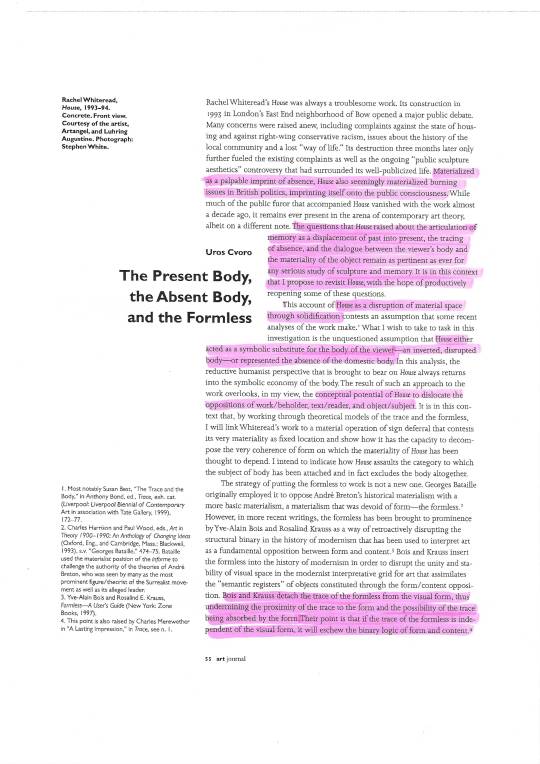
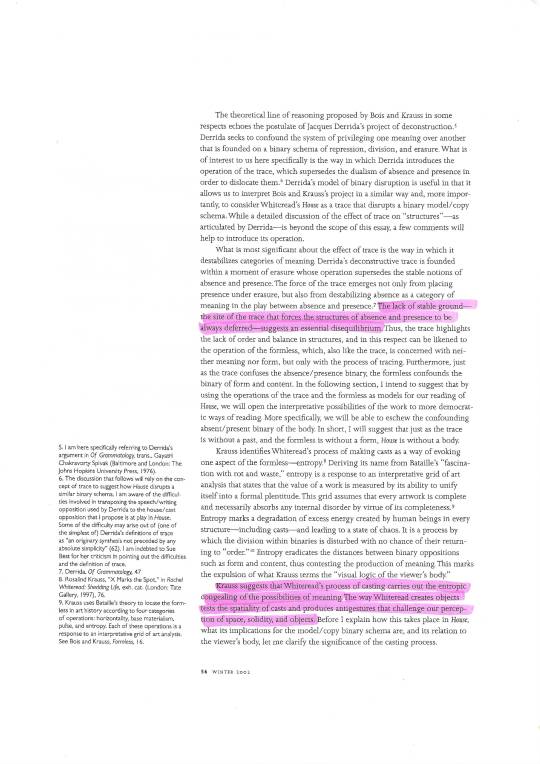
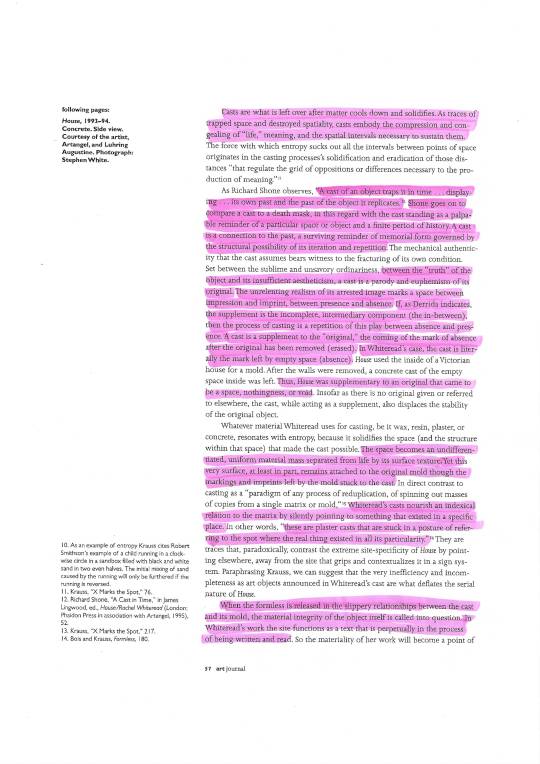

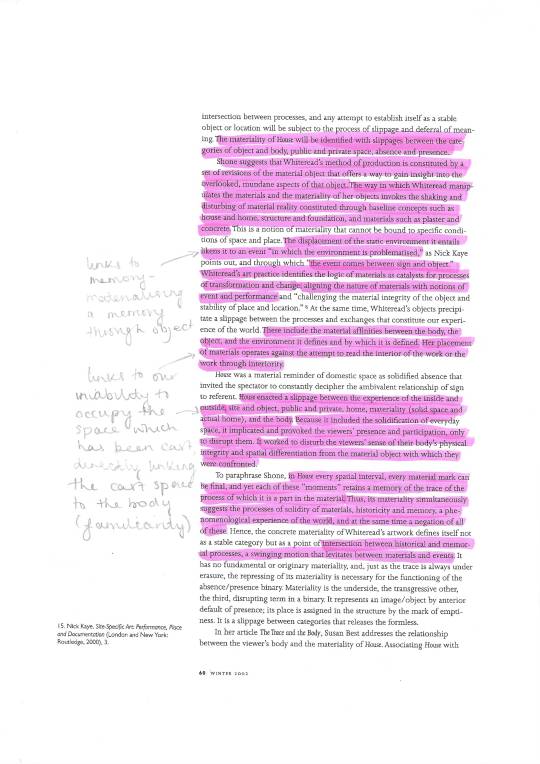
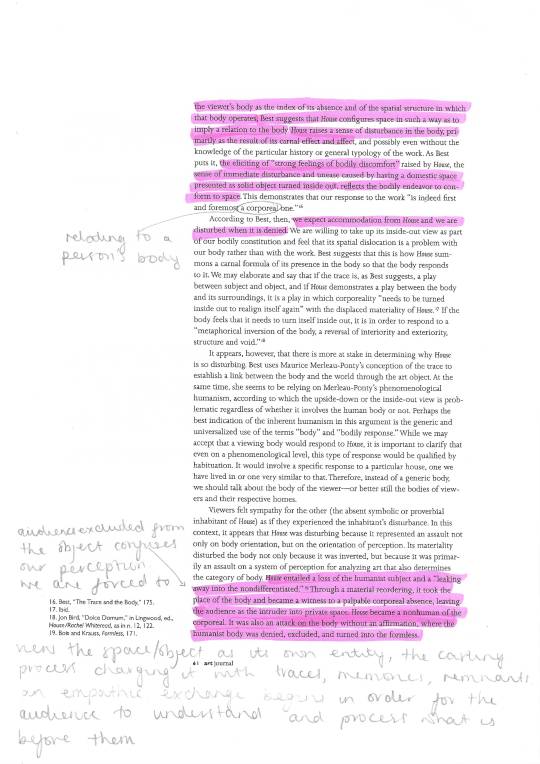
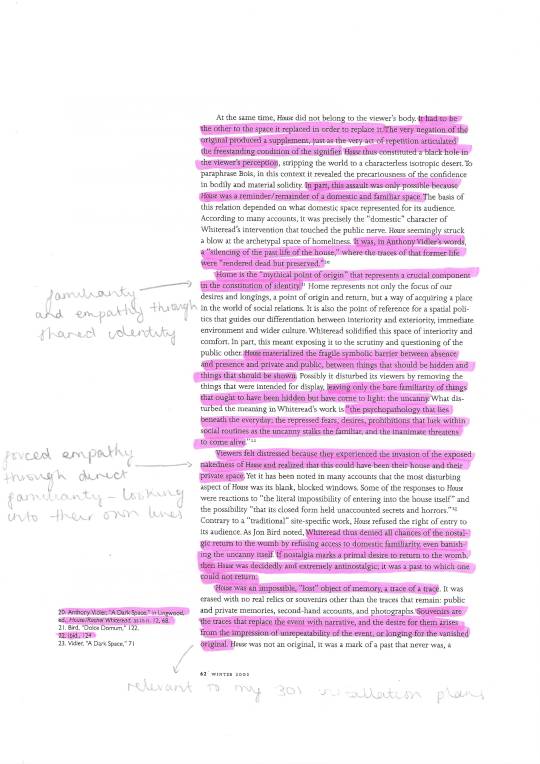

Notes:
Page 55 – ‘Materialised as a palpable imprint of absence, House also seemingly materialised burning issues in British politics, imprinting itself onto the public consciousness.’
‘The questions that House raised about the articulation of memory as a displacement of past into present, the tracing of absence, and the dialogue between the viewer’s body and the materialist of the object remain as pertinent as ever for any serious study of sculpture and memory. It is in this context that I propose to revisit House, with the hope of productively reopening some of these questions.’
‘House as a disruption of material space through solidification.’
‘House either acted as a symbolic substitute for the body of the viewer – an inverted, disrupted body – or represented the absence of the domestic body.’
‘There is a conceptual potential of House to dislocate the oppositions of work/beholder, text/reader, and object/subject.’
‘Bois and Krauss detach the trace of the formless from the visual form, thus undermining the proximity of the trace to the form and the possibility of the trace being absorbed by the form. Their point is that if the trace of the formless is independent of the visual form, it will eschew the binary logic of form and content.’ (Bois and Krauss, 1997).
Page 56 – ‘The lack of stable ground – the site of the trace that forces the structures of absence and presence to be always deferred – suggests an essential disequilibrium.’
‘Krauss suggests that Whiteread’s process of casting carries out the entropic congealing of the possibilities of meaning. The way Whiteread creates objects tests the spatiality of casts and produces anti-gestures that challenge our perception of space, solidity and objects.’
Page 57 – ‘Casts are what is left over after matter cools down and solidifies. As traces of trapped space and destroyed spatiality, casts embody the compression and congealing of “life”, meaning and the spatial intervals necessary to sustain them.’
Richard Shone, (1995). A Cast in Time: ‘A cast of an object traps it in time… displaying its own pasts of the object it replicates.’ ‘Shone does on to compare a cast to a death mask, in this regard with the cast standing as a palpable reminder of a particular space or object and a finite period of history. A cast is a connection to the past, a surviving reminder of memorial form governed by the structural possibility of its iteration and repetition.’
‘Between the “truth” of the object and its insufficient aestheticism, a cast is a parody and euphemism if its original. The unrelenting realism of its arrested image marks a space between impression and imprint, between presence and absence. If, as Derrida indicates, the supplement is the incomplete, intermediary component (the in-between), the process of casting is a repetition of this place between absence and presence. A cast is a supplement to the “original”, the coming of the mark of absence after the original has been removed (erased). In Whiteread’s case, the cast is literally the mark left by empty space (absence).’
‘House was supplementary to an original that came to be a space, nothingness, or void.’
‘The space becomes an undifferentiated, uniform material mass separated form life by its surface texture. Yet this very surface, at least in part, remains attached to the original mold though the markings and imprints left by the mold stuck to the cast.’
‘Whiteread’s casts nourish an indexical relation to the matrix by silently pointing to something that existed in a specific place. In other words, “these are plaster casts that are stuck in a posture of referring to the spot where the real thing existed in all its particularity.”’ – Bois and Krauss, Formless, page 180
‘When the formless is released in the slippery relationships between the cast and its mold, the material integrity of the object itself is called into question. In Whiteread’s work, the site functions as a text that is perpetually in the process of being written and read.’
Page 60 – ‘The materiality of House will be identified with slippages between the categories of object and body, public and private space, absence and presence.’
‘Shone suggests that Whiteread’s method of production is constituted by a set of revisions of the material object that offers a way to gain insight into the overlooked, mundane aspects of that object. The way in which Whiteread manipulated the materials and the materiality of her objects invokes the shaking and disturbing of material reality constituted through baseline concepts such as house and home, structure and foundation, and materials such as plaster and concrete.’ – Links to my progressing work based on site specificity and the structure/foundation/shell.
Nick Kaye, (2000). Site-Specific Art: Performance, Place and Documentation: ‘The displacement of the static environment it entails likens it to an event “in which the environment is problematised”. “The event comes between sign and object.” Whiteread’s art practice identifies the logic of materials as catalysts for processes of transformation and change, aligning the nature of materials with notions of event and performance.’ – Links to memory, materialising a memory through object.
‘Whiteread’s objects precipitate slippage between the processes and exchanges that constitute our experience of the world. These include the material affinities between the body, the object, and the environment it defines and by which it is defined. Her placement of materials operates against the attempt to read the interior of the work or the work through interiority.’ – Links to our inability to occupy the space which has been cast, directly linking the cast space to the body (the familiar).
‘House enacted a slippage between the experience of the inside and outside, site and object, public and private, home, materiality (solid space and actual home), and the body. Because it included the solidification of everyday space, it implicated and provoked the viewers’ presence and participation, only to disrupt then. It worked to disturb the viewers’ sense of their body’s physical integrity and spatial differentiation from the material object with which they were confronted.’ – Again, links to our inability to occupy the space which has been cast, directly linking the cast space to the body (the familiar).
Richard Shone (1995) – ‘In House, every spatial interval, every material mark can be final, and yet each of these “moments” retains a memory of the trace of the process of which it is part in the material. Thus, its materiality simultaneously suggests the processes of solidity of materials, historicity and memory, a phenomenological experience of the world, and at the same time a negation of all of these’.
‘Intersection between historical and memorial processes, a swinging motion that levitates between materials and events.’
Page 61 – Susan Best, (1999) The Trace and the Body: ‘The viewer’s body as the index of its absence and of the spatial structure in which that body operates, Best suggests that House configures space in such a way as to imply a relation to the body. House raises a sense of disturbance in the body, primarily as the result of its carnal effect and affect.’ The eliciting of “strong feelings of bodily discomfort” raised by House, the sense of immediate disturbance and unease caused by having a domestic space presented as solid object turned inside out, reflects the bodily endeavour to conform to space. This demonstrates that our response to the work “is indeed first a foremost a corporeal one”’. (Corporeal = relating to a person’s body). ‘We expect accommodation from House and we are disturbed when it is denied.’
‘House entailed a loss of the humanist subject and a “leaking away into the nondifferentiated.” (Boi and Krauss, 1997: p.171) Through a material reordering, it took the place of the body and became a witness to a palpable corporeal absence, leaving the audience as the intruder into private space. House became a nonhuman of the corporeal. It was also an attack on the body without an affirmation, where the humanist body was denied, excluded and turned into the formless.’ - Audience excluded from the object confuses our perception. We are forced to view the space/object as its own entity, the casting process charging it with traces, memories, remnants, an empathic exchange begins in order for the audience to understand and process what is before them.
Page 62 – ‘It had to be the other to the space it replaced in order to replace it. The very negation of the original produced a supplement, just as the very act of repetition articulated the freestanding condition of the signifier. House thus constituted a black hole in the viewer’s perception.’
‘In part, this assault was only possible because House was a reminder/remainder of a domestic and familiar space.’
‘It was, in Anthony Vidler’s (1995) words, a “silencing of the past life of the house,” where the traces of that former life were “rendered dead but preserved.”’ (p.12)
‘Home is the “mythical point of origin” that represents a crucial component in the constitution of identity.’ (Bird, 1995: p.122) – Familiarity and empathy through shared identity.
‘House materialised the fragile symbolic barrier between absence and presence and private and public, between things that should be hidden and things that should be shown.’
‘Leaving only the bare familiarity of things that ought to have been hidden but have come to light: the uncanny.’
“The psychopathology that lies beneath the everyday; the repressed fears, desires, prohibitions that lurk within social routines as the uncanny stalks the familiar, and the inanimate threatens to come alive.” (Vidler, 1995: p.71)
‘Viewers felt distressed because they experience the invasion of the exposed nakedness of House and realised that this could have been their house and their private space.’ – Forced empathy through direct familiarity – looking into their own lives.
‘Whiteread thus denied all chances of the nostalgic return to the womb by refusing access to domestic familiarity, even banishing the uncanny itself. If nostalgia marks a primal desire to return to the womb, then House was decidedly and extremely anti-nostalgic; it was a past to which one could not return.’
‘House was an impossible “lost” object of memory, a trace of a trace.’
‘Souvenirs are the traces that replace the event with narrative, and the desire for them arises from the impression of unrepeatability of the event, or longing for the vanished original.’ – Relevant to my 301 installation plans.
Page 63 – ‘It does not rely on memory to reproduce the past, it does not depend upon notions of revelation that refer to an originary site or mark a return to such a site: the economy of presence.’
‘This is an erasure (definition: the removal of writing, recorded material or data) because Whiteread’s object is a cast, an impression made by a void whose appearance is constituted by the erasure of such marks. The very structure of the sign is determined by the trace of what is forever absent.’
‘The presence of materiality of House took on meaning from its being an addition that replaced absence. It represented an irreversible past event, one that is always obliterated, a memory of what has never been present.’
REFERENCES:
Best, S., (1999). The Trace and the Body. The International Exhibition: Trace. pp. 172-176.
Bird, J., (1995). Dulce Domum. In: Artangel Trust, Bird, J., Lingwood J., (1995). Rachel Whiteread’s House. Phaidon Press. p.122.
Bois, Y-A. and Krauss, R. E., (1997). Formless – A User’s Guide. New York: Zone Books. p.171.
Cvoro, U., (2002). ‘The Present Body, the Absent Body, and the Formless’. Art Journal. pp. 54-63. Available at http://dx.doi.org/10.2307/778151.
Kaye, N., (2000). Site-Specific Art: Performance, Place and Documentation. London and New York: Routledge. p.3.
Shone, R., (1995). A Cast in Time. In: Artangel Trust, Bird, J., Lingwood J., (1995). Rachel Whiteread’s House. Phaidon Press.
Vidler, A., (1995). A Dark Space. In: Lingwood Artangel Trust, Bird, J., Lingwood J., (1995). House/Rachel Whiteread. London: Phaidon Press. pp. 12, 68, 71
5 notes
·
View notes
Text
To be more precise, Whitehead defines eternal objects as follows: “any entity whose conceptual recognition does not involve a necessary reference to any definite actual entities of the temporal world is called an ‘eternal object’” (1929/1978, 44). This means that eternal objects include sensory qualities, like colors (blueness or greenness) and tactile sensations (softness or roughness), conceptual abstractions like shapes (a helix, or a dodecahedron) and numbers (seven, or the square root of minus two), moral qualities (like bravery or cowardice), physical fundamentals (like gravitational attraction or electric charge), and much more besides. An eternal object can also be “a determinate way in which a feeling can feel. It is an emotion, or an intensity, or an adversion, or an aversion, or a pleasure, or a pain” (291). “Sensa”—or what today are more commonly called “qualia”—are “the lowest category of eternal objects” (114). But there are also “complex eternal objects” that have the simpler ones as components. In this way, affects or emotions are eternal objects; and so are “contrasts, or patterns,” or anything else that can “express a manner of relatedness between other eternal objects” (114). There is, in fact, “an indefinite progression of categories, as we proceed from ‘contrasts’ to ‘contrasts of contrasts,’ and on indefinitely to higher grades of contrasts” (22). The levels and complexities proliferate, without limit. But regardless of level, eternal objects are ideal abstractions that nevertheless (in contrast to Platonic forms) can only be encountered within experience, when they are “selected” and “felt” by particular actual occasions.
Whitehead’s use of the word “eternal” might seem to be a strange move, in the context of a philosophy grounded in events, becomings, and continual change and novelty. And indeed, as if acknowledging this, he remarks that, “if the term ‘eternal objects’ is disliked, the term ‘potentials’ would be suitable” instead (1929/1978, 149). But if Whitehead prefers to retain the appellation “eternal objects,” this is precisely because he seeks—like Nietzsche, Bergson, and Deleuze—to reject the Platonic separation between eternity and time, the binary opposition that sets a higher world of permanence and perfection (“a static, spiritual heaven”) against an imperfect lower world of flux (209). The two instead must continually interpenetrate. For “permanence can be snatched only out of flux; and the passing moment can find its adequate intensity only by its submission to permanence. Those who would disjoin the two elements can find no interpretation of patent facts” (338). Actual entities continually perish; but the relations between them, or the patterns that they make, tend to recur, or endure. Thus “it is not ‘substance’ which is permanent, but ‘form.’” And even forms do not subsist absolutely, but continually “suffer changing relations” (29). In asserting this, Whitehead converts Plato from idealism to empiricism, just as he similarly converts Spinoza, Leibniz, Hume, and Kant.
Steven Shaviro, Without Criteria
33 notes
·
View notes
Text
Ougi and Araragi
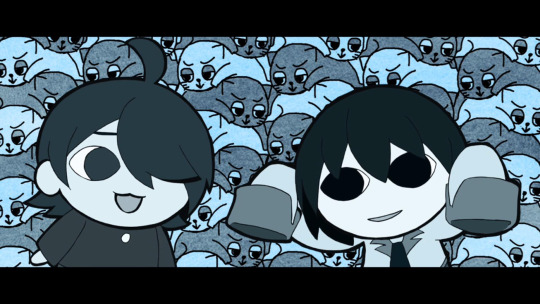
Hi! I was wondering if you could write a meta about Ougi from the Monogatari series.
It’s impossible to talk about one of them without talking about the other, so let’s discuss the unique relationship between Ougi and Araragi underneath the cut, the special relationship between a boy and his shadow.
1. Character Concept: The Jungian Shadow
There’s a lot that can be discerned about Ougi just from the type of character they are. Their relationship with Araragi defines them entirely, without Araragi there is no Ougi.
Ougi’s design is intentionally meant to parallel Araragi’s. Araragi has a very bland light novel protagonist kind of look to him (hence why he never gets any cover art) his only distinguishing feature is that his hair is styled to cover one eye at almost all times. This is because Araragi’s primary character trait is obfuscation looking at things through only one eye you are never going to get the entire picture.

If Araragi’s character design is plain and normal, because that is what the primary protagonist type of these kind of series are an ordinary high school boy, then Ougi’s is the opposite, their design is attention grabbing and unique. If Araragi is normal, Ougi is visibly abnormal, you can already tell there is something subtly off by looking at them. What Araragi hides underneath the surface, Ougi is.
The primary feature of Ougi’s face and the one you notice immediately is their eyes, large, dull eyes, which are the focus of their entire face. Ougi is always shown staring forward with those eyes, unblinking, directly at you. It’s symbolic, eyes are symbols of insight, if Araragi obfuscates then Ougi sees everything. Ougi also wears the Naoetsu high girls uniform. They take the appearance of what Araragi cares about the most, a girl that he can save. Their skin is pale, and their hair dark, which could mean two things, either black and white, light and shadow kind of thinking that Ougi represents or, it’s just supposed to make them look like the kind of ghost that is common in Japanese horror.
Finally, Ougi’s sleeves are so long that their hands are almost never shown. This indicates two things, one human hands are signs of intimacy. What are your hands for? is a pretty famous quote from Evangelion, by never showing their hands Ougi cuts off intimacy because they exist as a symbol of isolation. The next is that Araragi is characterized as someone who always reaches out a helping hand, whereas Ougi is the opposite they stress individual agency and often leave others like Nadeko to their own fate. They may orchestrate things from the shadows, but ultimately Ougi never directly acts, and let’s the characters decide to step off the cliff all by themselves.

The fact that Araragi a boy, makes Ougi appear as a girl is also a play on binary gender. Ougi is technically genderless, but they appear as a girl initially because themes of binary opposition, and black and white thinking are at play in their character. Araragi is someone who tends to see the world in a binary way. Light and dark, black and white, male and female, they assume there is some kind of proper order to the world that needs to be followed. When Araragi begins to let go of these ideas Ougi is freer to express their gender any way they like.
A binary opposition (also binary system) is a pair of related terms or concepts that are opposite in meaning. Binary opposition is the system of language and/or thought by which two theoretical opposites are strictly defined and set off against one another.

Ougi is based primarily on two ideas. One of them is a pretty obvious reference to the King of Distortion from Boogiepop, which is the series which started what we now call ‘Light Novels’ in Japan by popularizing urban stories with heavy sci-fi or fantasy elements. Araragi even directly references the king of Distortion.
“Tell me, what are you thinking about now...?” “Don’t suddenly become the king of Distortion.” Out with the cool quotes, scolded my sister. I deeply reflected on it. (Nekomonogatari White).’
The king of Distortion is a character who’s physical appearance and personality changes with every character they interact with, and who is able to enter the dreams of other people and see the desires in their heart after which point he makes an attempt to correct them.
While the King's personality changes with whatever person's form he is taking, in general, he seems to share a soft-spoken, calm and collected attitude each time, always seeming confident, most likely because of his knowledge of distortions in the hearts of each person's subconcious he enters. He claims his goal to be to 'turn the people's suffering into gold', which involves having people deal with their inner turmoils and coming to terms with them, which is why Boogiepop does not consider the King an enemy of the world, as he doesn't truly do anything particularly villainous.
King of Distortion like Ougi is also born from a single character’s regrets. The King of Distortion was born the moment Shirou Tanaka arrived at the Moon Temple. The main cause for the King's creation was the pent-up regret Shirou felt after entering a relationship with Naoko Kamishiro even though he didn't love her, figuring that he would just develop feelings for her later. After the girl's death, Shirou's self-hatred grew as he realized he wasn't particularly affected by her death in any real way. These feelings were also amplified by the fact that he knew about Akio Kimura, someone who truly loved Naoko, and deserved her way more than himself. These complex feelings of his manifested as the King of Distortion, a being born from Shirou's MPLS evolution.
King of Distortion is an entity born from repressed regrets and self hatred, what a character refuses to acknowledge about themselves or confront. Therefore, both King and Ougi are Jungian shadow archetypes.
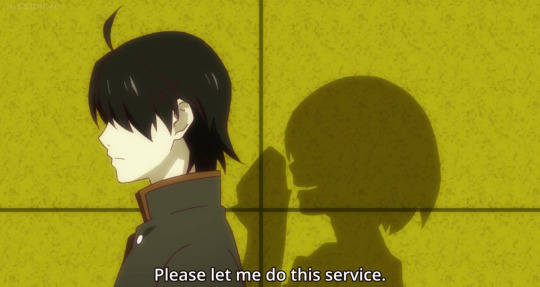
Both as one, one as both.
One is both, both are one.
The Niounomiya siblings with their slaughtering magic.
He and she pass their time in the same body.
Passing their shuttered time.
Passing their shuttered space.
She is Jekyll, and he is Hyde.
One as both, both as one.
Both are one, one is both. Hitokui Magical - [x].
Robert Louis Stevenson wrote the now famous tale, The Strange Case of Dr. Jekyll and Mr. Hyde, a story famous for its astute psychological insight that “Man is not truly one, but truly two.”
In Stevenson’s novel, Dr. Jekyll is a well respected doctor who cares deeply about the admiration of others and strives to be a good human being. In his laboratory he concocts a potion that when ingested transforms him into Mr. Hyde a primitive, unruly and destructive man. Reflecting on the nature of his transformation, he discovers a truth about the nature of a human being.
“I learned to recognize the thorough and primitive duality of man; I saw that, of the two natures that contended in the field of my consciousness, even if I could be rightly said to be the either, it was only because I was radically both.” [Source.]
The shadow exists in a dual relationship with the persona, developing in turn with it. In Jung’s terms the self, is the sum total of the psyche. Both is one, and one is both.
The persona comes from the latin word for “mask”, it’s the elements of personality which arises “for reasons of adaptation or personal convenience.” [Source.] It’s a simple idea, the way you talk around your friends is different from the way you talk in front of your grandmother. People are constantly choosing consciously which parts of their personality to show in front of others, especially in relation to how they would like to be perceived. It is a performance, but that does not mean it is not real. Every part of the identity matters.
It leans heavily on embodying only one’s best qualities, leaivng all those negative traits which contradict the Persona to form the “Shadow.” Jung called the shadow the part of the psyche the unconscoius aspect of the personality. Because one tends to reject or remain ignorant of the least desirable aspeccts of one’s personality, the shadow is largely negative. It consists of everything which exists outside of the light of consciousness, but it can be both positive and negative. “Everyone carries a shadow”, Jung wrote, “And the less it is embodied in a person’s life, the blacker and denser it is.” The shadow is unscious, things which our mind experiences but we cannot control, dreams, desires, instincts.
Without a well developed shadow, a person can easily become shallow and extremely preoccupied with the opinions of others, much like how we see Araragi act in Monogatari. Jung believed that, not wanting to look at their shadows directly, many people project those flaws onto other people.
In terms of literary theory then, the Jungian Shadow archetype is a character who is made up of all the flaws that the protagonist refuses to confront. They challenge the protagonist merely by existing, because the protagonist wants to look away and leave those qualities unacknowledged. Often, they are an antagonist merely because the protagonist projects all of the flaws they cannot see into themselves, onto that other person.
2. Araragi Koyomi - He Obfuscates

It is impossible to see the shadow without the light. It is impossible to describe Ougi without first talking about Araragi Koyomi. Just like Ougi, let’s start with the origins of his character. While this is just my own personal speculation I’m not NisioIsin, Araragi has always read as written in response to two things to me: First Ii-chan, the protagonist of his first series Zaregoto, and second harem protagonists in general.
II-chan and Araragi are both very flawed and non-confrontational human beings, but whereas Zaregoto is a story about how II-chan really does not want to change himself and instead just kind of wants to stay treading water, wants to never cause any more ripples, wants to hold onto the fragile sense of self he has Araragi’s is a story of a bad and hypocritical, shallow kind of person striving to grow up and become a good person, acquire depth.
The stereotypical harem protagonist is this, a plain guy with no personality who somehow gets girls to fall all over him, often for showing them the bare minimum of kindness. Monogatari is partially a deconstruction of harem series because it shows the kind of circumstances that would cause all these girls to fall all over one guy, literally they are all so deprive of affection that the smallest show of kindness does actually make them fixate on Araragi.
The thing is Araragi does have a clear personality. He is very cynical, he’s judgemental of other people, he really likes to snark. Part of the reason he likes talking to Senjyogahara so much is he can be meaner, and sharper tongued than he normally presents himself as around people. He has traditional black and white views of justice. He tends to meddle. He is observant, but his style of thinking is flawed because he tends to jump to conclusions quickly rather than thinking out the details slowly and methodically. He’s almost constantly anxious, but usually responds to the anxiety with avoidance. However, a lot of his more distinct personality traits sound more negative rather than positive, so Araragi has a version of himself he presents to others who he is less close to. This ‘self’ is much more vague, and wishy-washy, very go with the flow. Despite the fact that Senjyo and Hanekawa both comment that Araragi is well known among the students as a delinquent, Araragi himself says that he’s a typical high school student with a completely normal personality. He defines himself as vague on purpose, that sole purpose being to appear as more acceptable to others, because like an ego that refuses to acknowledge his shadow Araragi is very shallow and defines himself entirely on the opinions of the other people around him.
He is lacking a sense of self, or rather that sense of self eventually escapes from him when his shadow runs away Peter Pan style and becomes Ougi.
Araragi has three primary character flaws that manifest in the form of Ougi, Araragi is a hypocritical altruist who only cares about weak girls that need to be saved, Araragi obfuscates, and Araragi only thinks in black and white.
Araragi is not someone who helps people because it is the right thing to do. He does not do good deeds because they are good. He only helps others because there is something he gains out of it. One thing that’s important about Araragi is that he has a cripplingly low self esteem, to the point of self harm, self flagellation, and even suicide attempts.
He literally says so when he finds Kiss-Shot’s body, his first response is not to call for help but rather to try to let Kiss-Shot kill him, apologizing for living such a worthless life until this point. It’s not just that Kiss-Shot was in trouble, Araragi also made it about his own self loathing.

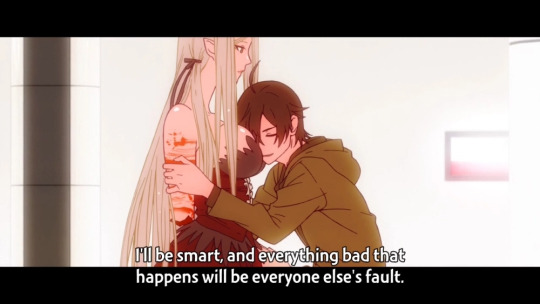
Araragi seems selfless to a fault, but he’s actually very self obsessed. While it’s true that Araragi desires to be a good person, and improve as a person, his methods for self improvement are faulty. He’s obsessed with appearances, and it’s more like he wants the appearance of a good person rather than actually having to put in the work at first. He wants to feel like he’s saved others. He wants to feel like he is someone worth something. He saves others because it increases his self worth, and also once again he gets something out of it. Araragi saving women that are weaker than him makes him feel special, like somebodyy needs him.
He wears the persona of a hero, rather than actually trying to be one. It happens again and again in the series. Despite the fact that Araragi actively does heroic things literally all the time, he also denies any role of being a hero because he does not want the responsibility of being one. Araragi wants the world to be burger king, he wants to have it his way. He wants the best of both worlds, Hannah Montana style. He wants to save girls, but he doesn’t want to be their hero and be entirely responsible for them.
“Araragi-kun, even if you can become a star, you can’t become a hero.” “I can’t become a star.” I shook my head. “I can only become a vampire.” And I even failed at that. “I see.” So you’re not going to be - my hero.
Nekomonogatari: White (Hanekawa and Araragi)
Take his actions in Nekomonogatari. Araragi claims it’s impossible to be a hero, he says that Hanekawa cannot be saved and calls for her to take personal responsibility and face everything that is wrong with her life. However, rather than trying to just support her with that difficult task Araragi immediately jumps to self harm.
It’s impossible for Araragi to become a hero, but he can swallow a katana and then trick Hanekawa into killing him because that is somehow easier than facing his feelings for Hanekawa head on. Araragi prefers bloody, painful self harm to the terrifying ordeal of being known. Araragi knows that Hanekawa is in need of help, but the fact that she is such a messy person different from the person he originally saw her as, makes him afraid of her.
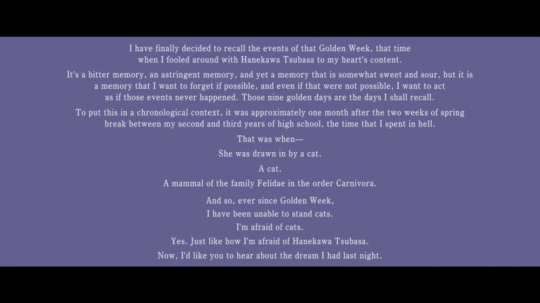
The thing is human beings are really sloppy. They are a messy gray, and Araragi wants to save them, but he really is just a kid out of his depth with a lot of things. He sees the abuse of Hanekawa’s household, and because he’s literally never even encountered an abusive life he gets so terrified that he runs away screaming. He does care about Hanekawa, but she’s far too complicated for him. He does not even want to touch that mess. It’s much easier for him to see Hanekawa as a hero, all black, or all white, then try to attempt something he does not know how to do and could screw up Hanekawa even worse.
Once again while it is not Araragi’s responsibility to fix an abused girl, and it makes sense a normal high school kid does not understand coping with abuse at all, Araragi at the same time wants to help her. Instead of just admitting that he can’t do anything for Hanekawa, he play-acts at being a hero.
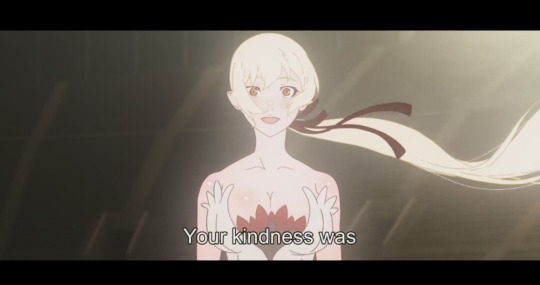
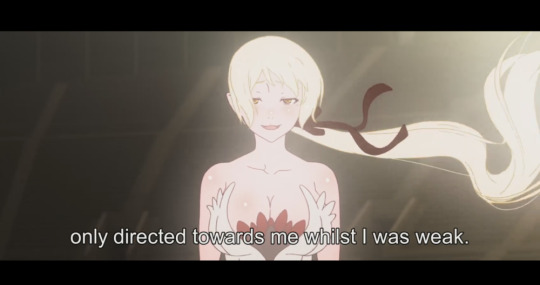
Here’s the thing about Araragi, have you ever once seen him try to save a boy? He only cares about helpless girls because those are the kind of people that heroes save. He does not care about people that are stronger than him, because then he is depending on them rather than the other way around. Araragi only interacts with about three male characters in the story significantly.
Oshino, who is an adult figure that Araragi aspires to be like, and then Kaiki and Seishirou who he both views as rivals for the two most important girls to him Senjyogahara, and Seishirou. Do you notice there is a far different tone in Araragi’s interactions with Seishirou and Kaiki? Araragi absolutely refuses to see Kaiki as anything other than a villain, and while Seishirou is clearly a victim, Araragi cares very little about actually saving him and instead prioritizes competing with him over Kiss-Shot.
Once again this is dude psychology that is present in Harem series. Did you notice if male characters do show up in harem series they are oftentimes, either comic relief, they are terrible people for the main character to look good in comparison, or they are old men mentor types. That is because any other man who would exist in a harem series is automatically competition for the girls. Araragi does not want to compete, he does not want to feel inferior to anyone else, because he always feels inferior all the time therefore he never has any male friends.
Therefore it’s hypocritical altruism, while Araragi is willing to help and that’s a good thing, he also never once helps unless there is something he gains from it. Even if it’s a chance to exercise his self loathing. Once again Araragi’s self loathing is incredibly harmful, he literally gets bones broken, limbs severed, and organs torn out almost every time he helps someone. Not only that but it’s always the first solution he jumps to. This is not the behavior of a healthy person, this is the behavior of someone attempting to punish themselves. Helping these girls by martyring himself is an act of attrition for Araragi, because he believes he deserves pain for all of his hypocrisies, but once again it’s still self obsession. Just hating yourself, just beating yourself up, is different from having to do the actual work of facing yourself and picking yourself up. Araragi will always choose dishonesty over honesty, obfuscation over seeing things clearly.
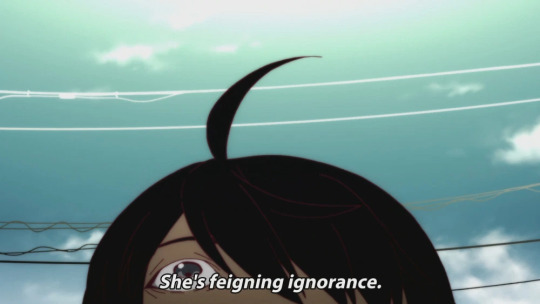
Araragi’s primary strategy of dealing with these many hypocrisies and contradictions in himself, and keeping his ‘ego’ in balance has always been obfuscation. Araragi is observant, but he presents himself as ignorant. He always goes on claiming how stupid he is, and how he’s nothing more than a worthless washout.
This is because Araragi was raised with an overpowering sense of responsibility. While his parents are not necessarily bad parents, they are police officers. He was raised made to feel responsible for things like justice, saving others, and especially made to feel responsible for his own flaws. Police officers are also symbols of justice, who as human beings often fall far short of the law and authority they are supposed to represent, because symbols are symbols and humans are humans.
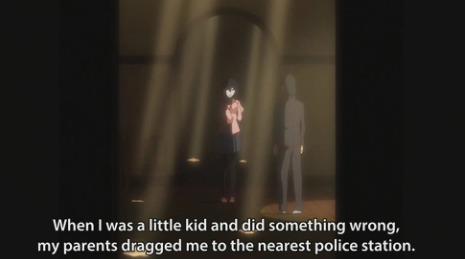
Therefore, what Araragi wants to avoid at all costs is feeling responsible. He wants to be important, but he never wants to take the responsibility of actually being important. This is his immaturity, the part of him that refuses to grow. For Araragi, if situations are too complicated for him to handle, or he fears his meddling will only make things worse and therefore he will be indicated as responsible his response is to just avoid it entirely rather than struggle or try.
This is shown in the case of Sodachi Oikura, once again someone that Araragi knew about and sympathized with but at the same time could not comprehend. Sodachi lived in horribly abusive circumstances, and both times Araragi encountered her he was a child. Araragi at the same time takes far too much responsibility, and far too little. It’s completely understandable that Araragi a middle schooler had no idea what to do to deal with what was obviously an abusive household, most adults are pretty useless when it comes to handling abused children. Yet, at the same time Araragi avoids any responsiblity whatsoever, he just forgets about Oikura claiming he has a bad memory depsite encountering her at three different significant parts of his life. Rather than struggle and fail, it’s better for Araragi to just not know anything at all therefore it can’t be his fault.
When Ougi drags Araragi through Sodachi’s case, Ougi ‘deduces’ everything, but Ougi’s catchphrase is I only know what you know. Ougi cannot have come to a conclusion that Araragi did not already know or was not capable of figuring out on his own, Araragi just did not think of those things because it was too painful to think.
This is also present in his dealing with other characters. There are several characters who have heavy romantic crushes on Araragi while Araragi is already in a relationship, Nadeko, Hanekawa, etc... Rather than ever just going through the awkward interaction of rejecting them it’s much easier to just pretend he never even notices their affections. Therefore we see him hypocritically, have a girlfriend, at yet at the same time constantly hang out with other girls who have a clear attraction to him and romantic feelings for him and never do anything about it.
Nadeko turns into a god because of obfuscation, both on Araragi’s part and on Nadeko’s. Nadeko is called out for what a hypocritical person she is never wanting to face anything directly, but that behavior is only a reflection, a foil to Araragi’s own, hence why Araragi was never able to save her.
Once again, Nadeko clearly has several problems with her personality, and she also blatantly hits on Araragi several times despite one being a middle schooler, and two Araragi having a girlfriend. Rather than just reject her outright, or acknowledge these parts of her personality, Araragi chooses to ignore everything and reduce her to being a cute girl. Nadeko puts on the act, and Araragi perceives. He then ignores all of her feelings, until they repress more and more and then bubble out into a jungian shadow expression that is Snake God Nadeko who just indulges on all of her instincts and desires and gives up conscious thought and her persona completely.
Ougi always mocks Araragi has a helpless fool, because that is what Araragi wants to be, helpless, foolish, and therefore not at fault when there are unintended consequences of his actions.
Finally, Araragi only thinks in black and white. This is also part of his obfuscation, he never wants to acknowledge how complicated people are. When he’s forced to confront the ugly side of people he almost always looks away.
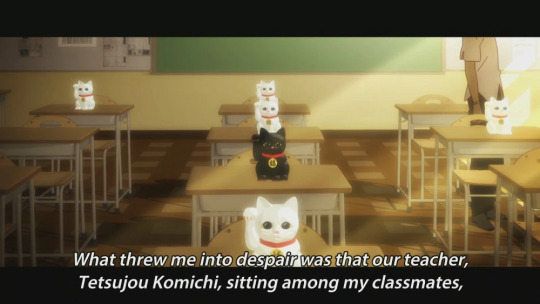
Black cats, white cats, hmmm, I wonder what that means. Araragi was only disappointed with the idea of justice, because he wanted to believe in it in the first place. He wants to believe that things like heroes can exist, and that his black and white perceptions of the wolrd are real. Araragi craves that order more than anyone else, perhaps even more than his younger sisters who just play at being heroes of justice. The reason he becomes so disillusioned is because he expects there to be an order of things, for their to be roles just like in a story, for their to be a sequence of events with meaning.
Araragi expects narrative rules to apply to real life. For life to have meaning. That is why he is a story teller. There are monsters and oddities, and humans with a clear line between them, despite the fact that Araragi himself is someone who blurs these lines by existing as a quasi vampire. Araragi’s life is a story that he tells himself, and that’s why it’s so important that his perceptions are so off. In Tsuki he even gets called on this twice, he calls his increasing vampirism punishment instead of just consequences for his actions and he’s told not to think he’s so special that god would go out of his way to punish him. Tadatsuru asks why they are facing off like this, why Araragi is protagonist and he is antagonist.
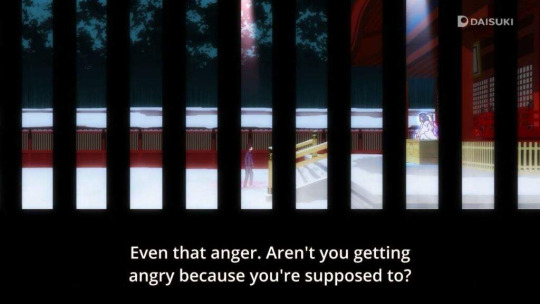
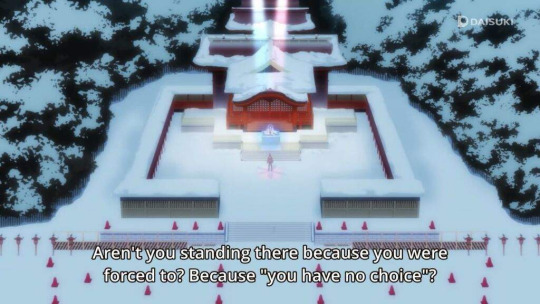
Araragi does not like acknowledging how sloppy the world is, because that makes him feel insignificant and weak. It would make anybody feel that way, because it means acknowledging that we are not as in control of things as we would like to be.
3. Oshino Ougi - They Reveal
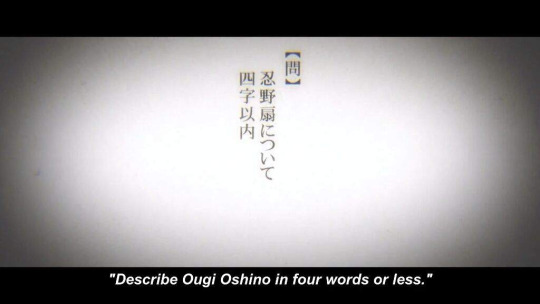
Ougi Oshino is Ougo Oshino.
They are a vague existence, Araragi refuses to define them because defining Ougi means defining themselves and that kind of confrontation is the last thing Araragi wants.
Ougi Oshino is born out of a desire for Araragi to punish himself, the same way he always seeks external punishment by allowing people to beat him up and rip out his intenstines. Rather than confront what is inside of him, Araragi externalizes it and confronts it as an external force which he projects upon.
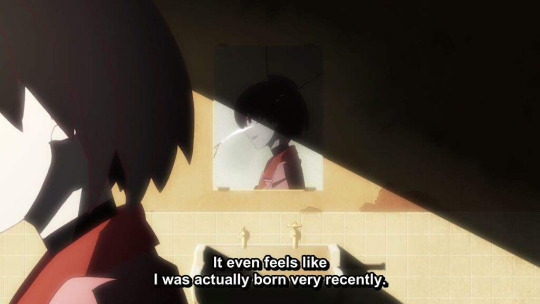
Ougi is a shadow born from the light of Araragi’s ego. It was not the darkness that created them, but rather Araragi himself and the shadow he cast. Therefore while Ougi can be seen as a corrective force, they actually embody all of those flaws that Araragi has, and their own character traits are always in response to those flaws.
Wheraes Araragi is a hypocritical altruist, Ougi is someone who exists to fix people’s mistakes, or punish them for their mistakes rather. Despite manipulating them, Ougi also ultimately leaves them up to their own fate. He leads them up to the cliff but does not push.
Ougi is a hypocritical fixer, because while he seems to be punishing others for their mistakes he really only exists to punish himself in the form of Araragi. All of the ‘mistakes’ he corrects are just Araragi’s own mistakes foiled in other people.
Nadeko is a foil to Araragi, she represents his own feigning of innocent and being unknowing. Kaiki is a foil to Araragi, he represents how much of a fake Araragi is by pretending to cling to ideals of justice and saving others but also denying them as well. Sodachi is also like Araragi, they both prefer to wallow in misery than try to work towards their own happiness. Araragi even says his famous line with his relationship with Shinobu, an ending where everyone is miserable, where nobody gets what they want. There are serious problems with his current relationship with Shinobu, a power imbalance, and both know they cannot last this way forever but rather than attempting to fix their relationship they both cling to the way thing’s are.
Repression and obfuscation is always favored over directly addressing the issues, especially the things which Araragi probably cannot control, or fix, like the complicated nature of abuse. Ougi claims they operate out of some imaginary set of rules that totally exist, but once again Ougi is the hypocrisies of Araragi laid bare. They are every bit the hypocrite that Araragi is.
They are just punishing other people who reflect Araragi’s negative traits. Those who do not acknowledge their shadow, will project their flaws onto other people and see themselves in other people in order to cope.
Ougi is made up of Araragi’s repressed desires. They are a girl he wants to save, which is the only type of person Araragi interacts with. At the same time, they are also connected to Oshino, who is Araragi’s model in the series for adulthood and maturity. Oshino who is always able to figure things out, and very self-collected often making fun of Araragi for his youthful excitement and his naivete for not knowing much about the world.
While Araragi presents himself as an idiot, Ougi is intelligent an capable of figuring things out from scraps of information. Araragi jumps to conclusions, Ougi is deductive and a good thinker. Ougi Oshino already knows Araragi better than himself, therefore Araragi does not have to carry any of the burden of self reflecting, or making himself known to other people around him.
During Ougi and Arraagi’s first meeting in the anime, he hallucinates that the classroom that he is locked inside of floods with water. The depths of the water, the shadow, dreams, these are all the realm of Jung. If the conscious mind is the water’s surface, then the subconscious is its depths.
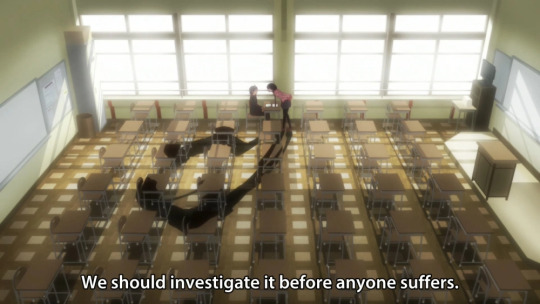

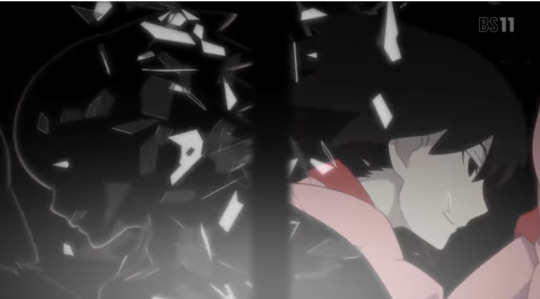
Araragi obfuscates, whereas Ougi reveals the uncomfortable truth. Ougi always positions themselves as a detective. In the realm of stories, it is the detective who makes the big reveal at the end. After all Ougi even says when they are locked in the room together, because there is no famous detective that Ougi themselves will play the role and announce the culprit.
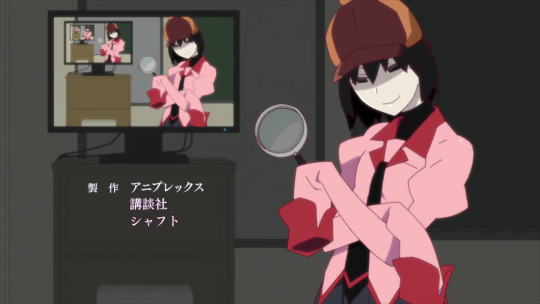
However, Ougi’s reveals are just as hypocritical as Araragi’s obfuscations. Ougi takes the shadow to be representative of the whole self, because they themselves are a living breathing Jungian shadow, but just like Jekyll and Hyde man is both. He is not one or the other, he is both at the same time. Ougi always act with the assumption that there is some kind of truth to be revealed, that this is just like a detective novel where there is a reveal waiting at the end.
Ougi takes the repressed desires to count as the “truth” of the whole mind, and ignores the conscious mind entirely. Therefore, in their view Nadeko is only capable of being a selfish cute girl who sees herself as a victim, Hanekawa is only something scary which Araragi must avoid. They at the same time as Araragi both read the same black and white narrative of the world. They do not care at all for the persona, or how people choose to present themselves. Desipte what Kaiki said to Nadeko that people can choose to be whoever they want to be, and they can try as many times as they like.
Ougi also views themselves as inhuman, and therefore incapable of doing anything, or defining themselves as anything outside of their role. Ougi is in a way, just as repressing of themself as Araragi is. They even lament this in front of Tsukihi, that once the detective reveals the mystery the novel is over. That if anybody would know the truth of them, they would come to hate them because they are abhorrent.

Ougi by repressing concious thought, silences other people and what they have to say about themselves. The only thing that matters is the repressed, what Ougi dictates as the truth must then become the truth. It’s just as much a limited way of saying the world as Araragi’s is. Hence Ougi’s famous catchphrase, I don’t know anything, you’re the one who knows. Ougi sees themselves as a person fundamentally incapable of knowing anything other than outside the bounds of what Araragi already knows.
Which is finally where the black and white thinking comes in. While the two of them seem like polar opposites, their views of the world are actually the same. Ougi wants what Araragi wants, for the world to exist like this is a story. For there to be roles, and order and most importantly meaning. The same way that Araragi just ignores things that fall out of step with their roles, when people contradict the way Araragi sees them he just pretends to be oblivious rather than see them as complex human beings. Ougi actively goes out of their way to punish people, for not playing the role in the story they were supposed to play. He acts like a corrective force, pushing people back into their roles. His wrongful assumption is not that people improve by “correcting mistakes” but rather there was a proper path in the first place. That there was a hero’s journey they were supposed to be going on. There is no path, there is no meaning, it’s all senseless but Ougi exists out of a desire for things to be sensible.


Ougi exists as Araragi’s opposite, because Araragi assumes that things like binary opposites exist in the first place. Heroes and villains, crime and punishment. They both believes these things exist in a fundamental order in the world, and they are not just made up values that humans invented and give meaning to.
“Let’s not joke. Virtue is the antonym of vice, not of crime.” “Are vice and crime different?” “They are, I think. Virtue and vice are concepts invented by human beings, words for a morality which human beings arbitrarily devised.” (No Longer Human, Osamu Dazai)
For both of them clinging to these hypocritical beliefs are better than the alternative, admitting to their own helplessness in the face of a world that is mostly indifferent to them.
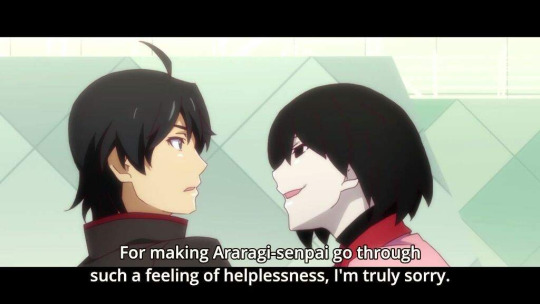
That’s why, when they are separate both of them choose to stick to their ultimately restricting and punishing roles, as protagonist and atagonist, persona and shadow, hero and villain, rather than just trying to acknowledge themselves and live as people.
Both is one, and one is both. Araragi Koyomi and Oshino Ougi have a relationship that ultimately results in not antagonism, but rather union and acceptance. Just like the King of Distortion is not an enemy of mankind in the enemy, Ougi was never an enemy to Araragi in the first place. Araragi never needed to hate himself or punish himself. The true path forward lies in union and acceptance.
You can never be anything more than yourself, nothing more and nothing left.
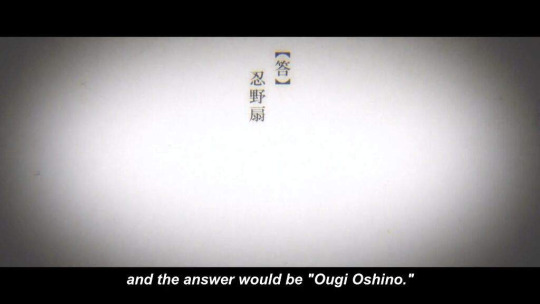
71 notes
·
View notes
Text

elias: did any episodes remind you particularly of any memories you made over the last decade, whether scary or not?
honestly none of them really had any instant strong connections for me? some of them reminded me of specific settings, like a lot of the hunt or wilderness focused ones made me think of my dad's extended family who are scattered across the pacific northwest, but there were no instant associations for me
martin: which entities would you have been an avatar of at the beginning of the decade? at the end?
at the beginning i was uhh 5 so probably beholding because kids like to learn stuff, but at the end i'm. hoo boy web/spiral with a pinch of stranger to taste probably
georgie: what did you do while listening to tma? did you listen with friends or other people?
back when i first got into tma i was doing concept art for a play i was in and i needed something to fill the time with! i also listened to it while walking home after rehearsal for said play sometimes but at that point it had become a driving force in my life so i was pretty much listening to it every chance i got. the only episode i actually listened to with other people was 160, and two of my friends and me had a little halloween listening party thing

michael: did the influence of any particular entities feature prominently in your decade? which ones?
there hasn't been one for the whole overarching decade besides probably the web, but going in vaguely chronological order probably the big boys have been beholding, stranger, web, spiral, lonely
sasha: which episode were you most afraid of on your first time listening?
HGGHgh number 3. good old across the street. i hadn't been expecting tma to be actually scary, because i had listened to the first two and been told about 65 binary and 86 tucked in and found them mostly intriguing and thought-provoking stories, but nothing that actually frightened me. i think it was the imagery of across the street personally because i remember like vividly imagining the statement giver on the bus, in her window watching graham, in class, repeat, and then just waiting for the other shoe to drop the whole episode and finally being greeted with just the arm reaching up through the window... that was *chef's kiss* for me it took a little longer to get hooked into the metaplot but 3 was what really got me revved up for the statements

leitner: did you do anything this decade you wished you'd listened to tma before doing? likewise, did you do anything you wished you'd listened to tma after?
the short answer here is yes to both, and the long answer is i wasn't able to process podcasts until this year but god i wish late 2018/early 2019 me had listened to tma because i had to write a credo for church and i feel like if i had taken those few months to process the mangus anchovies i would've been able to define my ideas much more clearly? idk my brain is fried and it's late o clock
#ask#sam.txt#there were a few more separate asks but they were all encapsulated in these three i think#apparently sasha and martin are hot questions... i see
9 notes
·
View notes
Text
Defining Queer: An Ontological and Epistemological Discussion of Queerness
To start with, I’m not a philosopher and I’m not a sociologist. I’m just a linguist who likes to talk about stories and use jargon-y words. I’ve been in fandom (in some form or another) since the late 90s, and I’m a bisexual/queer ciswoman married to a man. I say all of this so you understand where I’m coming from (my positionality, if you’re nasty).
I’m writing this piece because I see a lot of people in fandom spaces using terms like “queer”, “cishet”, “queerbaiting”, and others. I find use of these terms to generally be vague, misleading, or just downright wrong. There seems to be consensus in fandom that these are Important Things to talk about, but there doesn’t seem to be a consensus on what they mean. So, as a queer woman who has engaged in fandom for 20 years, I want to talk about the idea of queerness and what it means to be queer.
So, in this essay, I’m going to address three major questions:
What does it mean for an individual to be queer?
What does it mean for a relationship to be queer?
What does it mean for a piece of media to be queer?
I’m going to argue that for an individual to be queer is an ontological and epistemological issue, for a relationship to be queer is just epistemology, and for a piece of media to be queer is an epistemology plus diegesis. I’ll explain what these words mean (and how I’m going to use them), and I’ll have some sources sprinkled throughout. It’s generally Bad Academic Practice to source Wikipedia, but for the sake of accessibility and ease of explanation, Wikipedia is a good source for this essay.
Ok, so let’s define some terms. I’m going to start with the most obvious, but also perhaps the hardest to pin down: queer.
Queer is an umbrella term for sexual and gender minorities who are not heterosexual or cisgender. Originally meaning "strange" or "peculiar", queer came to be used pejoratively against those with same-sex desires or relationships in the late 19th century. Beginning in the late 1980s, queer activists, such as the members of Queer Nation, began to reclaim the word as a deliberately provocative and politically radical alternative to the more assimilationist branches of the LGBT community. (x)
So there are a few major takeaways for the word queer. The first one is that queer is inclusive--it’s an umbrella term. The second one is that it describes people who are not heterosexual and/or cisgender. A definition by saying “we are not x” is actually not a great definition, so we’ll come back to this point later. The third one is that queer is political, and it always has been; crucially, queer does not equal LGBT.
Now on to the jargon: ontology and epistemology both come from the field of philosophy, and diegesis has its origins in Greek theater, but I hear it mostly used now to talk about film.
Ontology is the study of being. Ontology asks questions like what is a thing? what exists? What categories of things are there? So, for my purposes, when I talk about ontology, I’m talking about categorization and identity. What are the labels we give ourselves? What categories do we sort ourselves into? How do we identify ourselves?
Epistemology is the related study of knowing. Epistemology asks questions like how do we know something is true? how do we define truth? how do we make justifications? For my purposes, epistemology has a lot to do with how we define social truths and norms. What is true about human gender/sexuality/etc.? How does queerness affect one’s beliefs? I use worldview as a kind of short hand for epistemology in this essay, though epistemology is really only one part of a person’s worldview. But, for my purposes, worldview works just fine.
Diegesis refers to anything within a narrative text--characters, plot, setting, etc. are all diegetic (or intradiegetic). Things outside the text, like the score of a movie or the UI of a videogame, are extradiegetic.
Ok now that we have all the jargon down, let’s tackle the first question: What does it mean for an individual to be queer?
As I previewed above, I define queerness for an individual to be a matter of both ontology and epistemology. I want to come back to the definition of queer here, specifically the part that defines queerness as “not cisgender and heterosexual”. This is a bad category ontologically speaking, because the definition doesn’t point to all the things that make up this category, but rather the things that don’t. Queerness, in this definition, is a catch-all; I’m not sure that’s really an accurate way to think of queerness. At least in linguistics, the catch-all category is for the default, unmarked cases, and queerness is not that at all.
So I’m going to switch things up a little and change this part of the definition. Instead of defining queer by what it’s not, I’m going to define queer epistemologically. Queerness is not just not being heterosexual/cisgender, but a rejection of the heteronormativity (“the belief that heterosexuality, predicated on the gender binary, is the norm or default sexual orientation”). This rejection may derive from social ostracization and condemnation from same-gender attraction/behavior and/or gender non-conforming, but ultimately is not quite the same thing as LGBT.
Queerness and Queer Theory seek to deconstruct notions and norms of gender, sexuality, and all of the social baggage that comes along with them. Therefore, being asexual and/or aromantic is inherently queer as these identities are a rejection of social expectations for behavior. This deconstructionist impulse may even be at odds with people who identify as lesbian, gay, bisexual and/or transgender. For example, Natalie Wynn, in her video about Pronouns, discusses that her desire to be perceived as a woman is inherently counter to someone who seeks to eradicate or seriously challenge the gender binary (as with non-binary individuals).
None of this is to say that an individual person can’t identify as both L, G, B or T and also queer, but this is where we come back to ontology. Ontology has to do with how we identify and how we make categories. For example, I use both bisexual and queer to identify myself. I use bisexual because I experience sexual and romantic attraction to more than one gender, and I use queer because it includes this idea of challenging gender and sexual norms (and also it doesn’t necessitate explanation of all the details of my gender/sexuality).
Therefore, one person’s use of queer to describe themselves is both ontological, because they are defining and categorizing themself, and epistemological, because being queer is essentially a lens through which to know the world.
So, if an individual’s queerness is a mix of identity and worldview, what about a relationship?
A relationship can’t have an identity the same way that an individual human can, i.e. a relationship can’t pick a category for it to belong to because it’s not a sentient entity. Americans can categorize relationships by the genders of the people in that relationship--heterosexual for man+woman, homosexual for man+man or woman+woman. These categorizations, of course, exclude relationships that have more than two people, and people whose genders are not “man” or “woman”. But this still isn’t really the same thing as me, an individual person, choosing to use bisexual to label myself.
Therefore, a queer relationship isn’t really the same thing as a homosexual relationship, though they may overlap. Queerness, in a relationship, is entirely epistemological. How does the relationship operate?
Traditional heterosexual relationships (at least in 20th/21st century USA) privilege the man, and the woman is subservient. Men work outside the home and women raise children/do domestic work. Men and women in a traditional heterosexual relationship are supposed to have all of their emotional, physical, etc. needs met by their partner. Traditional heterosexual relationships are monogamous, both sexually and emotionally.
But a queer relationship questions accepted social norms. A queer relationship may not be monogamous, it may reject the traditional gender dynamic, and so on. What I’m ultimately saying is that a heterosexual relationship, that is a man and a woman in a relationship, can be queer. This is because queer relationship does not equal homosexual. I’ll give two examples.
I’ll start with the easier example: a heterosexual relationship only requires one man and one woman, but makes no stipulation that the man and woman have to be cisgender. There are plenty of transmen exclusively attracted to women and transwomen exclusively attracted to men. Just because the make up of their relationship is man+woman, doesn’t mean that their relationship isn’t queer. The queerness is baked in because they themself may be queer.
The second example seems to be more emblematic of a sticking point for some people. I am married to a heterosexual man, but we are in a queer relationship. Because I am queer, and it affects how I respond to social norms, I also reject heteronormativity in my romantic relationship. My husband and I have been together for almost 13 years and married for 3; for the longest time, I did not want to get married because the idea of marriage, specifically the traditional idea of marriage, disgusted me. To me, marriage is the realm of religion and the state, neither of which I wanted to be particularly involved in my relationship. The reasons we ended up getting married were practical (I now have health insurance!), but also because my husband is a big ol’ romantic and we compromised (we get married and I keep my name). This is just one example of how my notions of gender/sexual expectations have been a part of my relationship, but there are plenty of others. Also I am visibly queer and waiters often think we need two checks when we eat out together. ¯\_(ツ)_/¯
(If you want to see someone else talk about this, I recommend looking into Erika Moen’s autobiographical work. This tweet thread is just one example of her discussing being queer and being married to a man.)
Therefore, queer relationships are not about identity, but rather how the epistemology of one or both or all people in a relationship affects the operation and function of that relationship. A queer relationship is one that rejects heteronormativity, not one that exclusively consists of people of the same gender. This makes it sound like if a cisgender heterosexual man and cisgender heterosexual woman are in a relationship, it could potentially be queer, which I think is the fear of anyone who pushes back on the possibility of a man and a woman being in a queer relationship together. However, if the two individuals in a relationship are both cisgender and heterosexual, neither of them has rejected heteronormativity in one way or another (even if they have non-traditional gender roles in the relationship). Therefore, if at least one person in a relationship is queer (whether they be asexual, gender non-conforming, homo/bisexual, etc.) the whole relationship is queer.
Finally, I get to stories: What makes a particular piece of media queer?
As discussed for individual identity and relationships, a piece of media is queer because it has a queer epistemology. There is a way of constructing truth in a narrative that rejects heteronormativity, but it is important to discuss whether this rejection happens in the text of the work (diegetic) or the rejection is in social context in which the work was created (extradiegetic).
One interesting example is the Imperial Radch books by Ann Leckie. In these books, the main political force in the story doesn’t distinguish gender in its pronouns. Therefore, everyone the main character encounters is “she” regardless of their biology or gender identity. Within the story (diegetically), this is not queer. This is the established norm of a very large and powerful people, and just a function of their language. Now, outside the story (extradiegetically), the use of “she” is queer af. This is a deliberate choice by the author to question our assumptions about what is “normal” and “default”.
Steven Universe does something similar by having a race of sentient space rocks who only use “she” as their pronouns. Extradiegetically, this again challenges ideas about how the gender binary is “supposed” to work, plus the space rocks demonstrate a wide range of expressions of femininity. Within the story (diegetically), we see metaphorical of rejection of heteronormativity, specifically through Garnet and her story. Therefore, Steven Universe is both epistemologically and diegetically queer.
Does this make Steven Universe more queer than the Imperial Radch books? Maybe it does.
For me, Steven Universe “feels” queer, while the Imperial Radch books don’t. I really love the Imperial Radch books and the way they make you actively think about how “she” is generally not considered the default pronoun. But this is all outside the text. I engage with the text as a person in a particular social context where women are lower on the social hierarchy than men, but the characters in the Imperial Radch books don’t share this social context. The construction of social order for the gems in Steven Universe, to contrast, is similar to my social context, so both within the text and outside the text, Steven Universe is queer. This doesn’t mean that there isn’t a certain amount of subjectivity here, but for me, a queer show is one that is both diegetically and extradiegetically queer.
This brings me to queerbaiting, a word that seems to mean almost anything in fandom. I’ve discussed what queerbaiting is and how to define it here and here, but I wanted to come back to the definition from @rainbofiction:
“Queerbaiting is clinging to the heteronormative interpretation on the surface of things, and refusing to invalidate it, but still trying to present a queer reading in the background; metaphorically selling the hetero story from the front door, and the queer story out back.”
Queerbaiting is not necessarily ship tease, though there seems to be some conflation of the two. I’ve seen it used to discuss Sherlock, Supernatural, Teen Wolf, Voltron, Once Upon a Time, and other shows. I think queerbaiting as an idea can really only exist in an episodic format, since (save for streaming shows) you don’t get the story all at once. By being presented the story and characters bit by bit, you as a viewer don’t engage with the story as something full and complete, but instead the story as it’s being built. Because you don’t have the full story, your understanding and interpretation of the work can be affected by the text itself of course (diegetic material), but also all the extradiegetic and paratextual stuff that exists alongside the work.
Let’s think about books for a moment, specifically self-contained, standalone novels. Let’s pretend that Pride & Prejudice were not a complete story presented all at once, but rather released chapter by chapter with weeks or months passing between each chapter. If you started reading from the beginning of the work, you might make up your mind from the beginning that Darcy is the worst, and you and your friends talk about how Darcy is just awful and that Wickham fellow is soooo much better for Elizabeth. You might expect the work to continue to justify your position (coming back to epistemology), but it purposefully does not do that. Elizabeth and Darcy grow and change over the course of the novel, and end in a place of love and mutual respect.
But imagine Pride & Prejudice were released in the internet age, and you’ve spent a year (or two! Or five!) waiting for the end of the book to come, and then … this? After you’ve spent all this time engaging with people, creating fanworks, speculating about this idea of Elizabeth and Wickham, and in the end you are not rewarded by canon for your investment.
This is what queerbaiting feels like. But does that mean this is what queerbaiting is?
When I’ve discussed queerbaiting before, I’ve argued that queerbaiting is so difficult to identify because it requires two elements: 1) legitimate queer subtext, and 2) intent by the author(s) to mislead or swindle the audience. Queerbaiting is also tricky to talk about because if the work is incomplete (i.e. released episode by episode over time), you just cannot know if you’re being queerbaited.
I personally don’t want to conflate queerbaiting with shipping, because I do think they are two discrete issues, but this conflation seems to be the only way fandom talks about queerbaiting. To demonstrate, I’ll talk about The Magicians (the TV show).
To start with, The Magicians is a queer show. The show frequently challenges assumptions about heteronormativity--specifically the idea of soulmates/destiny in love, and that one person + another person = happiness and fulfillment. We even have an analog of queerness as a social taboo, with human/animal relationships in Fillory. Therefore, epistemologically, The Magicians is queer.
The Magicians also has multiple LGBT characters, at least three of which are main characters. No one on the show has told us the audience how they identify, but we have seen Margo, Eliot and Quentin express same gender attraction in one form or another. Diegetically, The Magicians is queer.
So, now that I’ve show that The Magicians is both epistemologically and diegetically queer, let’s talk about why the q-baiting word is used in discussions of this show.
This season had a landmark episode (4x05) that essentially sets up romantic feelings between two men (Quentin and Eliot) as a pillar of the narrative of this season. The boys didn’t get together (for lots of reasons) in that episode, but that episode made it clear that they both love each other, and that love is driving both of them the rest of the season. But in recent episodes, one of the boys, who has already been established to be bisexual, gets back together with his ex-girlfriend.
To summarize: The Magicians set up the expectation that Quentin and Eliot will be together in some capacity (though the show overall seems less concerned with ideas like “soulmates” and “endgame” but that’s another essay for another time), but at this point, it has not followed through. Like with my P&P example, I understand why this feels like queerbaiting, but is it?
I’m going to start with the ontological perspective: Quentin is bisexual regardless of the gender of his romantic and/or sexual partner. However, Quentin isn’t a real person, and as I’ve talked about already, ontology doesn’t really work for entities that aren’t living, breathing people. Quentin hasn’t told us the viewers that he’s bi, so all we have to go on is her behavior (something that should never ever ever be used to talk about a real life person’s sexual/gender identity)--his actions as a fictional character in a narrative.
So looking at his behavior, at this one time slice in an ongoing story, it can appear like the expectations for a romantic relationship between Quentin and Eliot will not be met. But this comes back to the problem of episodic storytelling. It is impossible at this point to say “well I guess Quentin and Eliot aren’t endgame, hence queerbaiting” because the story isn’t over. We have one more episode to go in this season and (at least) another season on the horizon. Who knows what will happen between now and then.
Additionally, as discussed before, The Magicians is epistemologically queer. The Magicians is not giving us a heteronormative story with queer subtext--the queerness is inherent to the text (and not just because there are LGBT characters). So taking shipping out of the equation for a moment, The Magicians is not queer by subtext or interpretation; The Magicians is queer because it overtly rejects heteronormativity.
Here’s some ways it does this:
Eliot (a mostly gay man) and Fen (a woman) come to care for each other despite having an arranged marriage. They have a romantic, sexual, and familial relationship.
Penny40 and Kady were in love, but Penny23 loves Julia. Relationships aren’t set in stone, there is not one person “meant” for another.
Whenever expectations of straightness and man-ness are mentioned in text (see Hyman and Penny’s supervisor in the Underworld branch)
This is a non-exhaustive list, but it demonstrates how heterosexuality and all the other social expectations that come with it are explicitly deconstructed by the show. Therefore, The Magicians cannot queerbait because it is diegetically and epistemologically queer.
Ok, so I’ve covered a lot of ground, but here are my major points:
Queer =/= LGBT, though the two do overlap. Queerness is a rejection of heteronormativity; it is radical, deconstructionist and political.
An individual being queer is different from a relationship being queer or a show being queer.
An individual’s queerness is a matter of identity (ontology) and worldview (epistemology).
A relationship is queer through the way it operates, the way it rejects heteronormative assumptions about how relationships should operate (epistemology).
A piece of media is queer through worldview (epistemology) but how much of that is baked into the text (diegesis) is important too
Queerbaiting is often conflated with shipping (specifically shipping on non-canon m/m and f/f pairings), but they are two separate issues.
It is impossible to know if expectations about a m/m or f/f ship will be met while the story is still in progress.
A piece of media cannot queerbait if it is epistemologically queer.
The reason I sat down and wrote this was to work through my feelings about what it means to be queer, and why I have always felt a little uncomfortable with the word “queerbaiting”. Queerness is something that is constructed in many ways, and I haven’t even really discussed much of the political or community issues. Ultimately it’s up to each of us as individuals to critically engage with both fiction as it portrays queerness, and how we police each other and reinforce categories. I think this essay can provide some framework for that engagement.
This was not written to invalidate anyone’s feelings; if you personally feel let down by a piece of media, you are entitled to those feelings. However, fandom can very quickly become an echo chamber, and rather than reinforce feelings, good or bad, I offer this framework as an alternative. It can helps us answer questions like : How does media construct queerness? Is it epistemological? Is it diegetic? Does it replicate expectations of heterosexual relationships but with people of the same gender? Does it stereotype? And by answering these questions, we can get to the heart of queerbaiting, both as a feeling and as something that exists in the world.
------
This essay comes out of many many long talks about gender and sexuality and queerness with @messier51. Her perspective helped me get my thoughts in order!!!
#gender and sexuality#the magicians#queerbaiting#tm meta#queliot#idk really what else to tag this as#philosophy#queer theory
124 notes
·
View notes
Note
(Part the 1st)Now that you are in the Chapter 50-52 bubble, I wanted to share something. I've messaged you before about how your continuous comparisons of Rand and Egwene's arcs helped/caused me to see the depth and complexity of their relationship, and the way in which Egwene acts as Rand's counterweight in the series, providing the a balance to the Dragon Reborn in a series that is, at its heart, about how vitally important balance between forces is (at least within a strict binary system).
(Part the 2nd) In light of that I wanted to add that I had previously been a little dubious of your theory that Lew’s Theron’s voice in Rand’s head was actually a defensive construct and not necessarily Rand’s madness. It just felt like the writing was so clear that LTT’s voice was legit, and maybe it is on some level. But I was recently rereading earlier sections as part of another read along (it covers 1-2 chapters a week and is in the TSR, who will finish first? :P lmao). But I noticedin the lead-up to the battle outside of Cairhein against the Shaido, there are SEVERAL instances of Rand just suddenly *having* memories or knowledge from LTT… and at this stage there was no voice at all. The voice doesn’t appear until AFTER Rand nearly runs himself to exhaustion in that battle. And it’s presented so faux casually (as in, it’s a big deal and it’s pointed out, but within the context of us seeing the beginning of Rand experiencing the Taint. Much like the Joker’sline in The Dark Knight about people being ok as long as events are following “The Plan” even if The Plan is horrific. We are expecting to see Rand loosing it, so we don’t really over analyze it when it happens) if I had not been primed by reading your analysis from that perspective, I probably would have just KEPT reading and not noticed, so once again; thank you for this blog and for adding ever more depth and meat to this series for me!
Yeah, I do talk about this one a lot. I’m glad it works for you!
And in my defence, it’s because most of the time I’m trying to work out what’s going on, as new information comes in and things change. Because it’s definitely taken me a while to figure out what’s happening – and I could very well be wrong! This is one where I think there’s a whole lot of space for different reader interpretations, depending on what makes sense to you (and, honestly, on what feels more satisfying to you; I often feel like explanations of a character’s internal landscape or mentality or psychology work better when they’re left a bit open to interpretation).
Your description of it as a “theory that Lews Therin’s voice in Rand’s head was actually a defensive construct and not necessarily Rand’s madness. It just felt like the writing was so clear that LTT’s voice was legit, and maybe it is on some level” is interesting because I never really thought of it in those terms; this is partly no doubt because I’ve been trying to work it out as the story unfolds, but also because I think the very nature of the whole…situation in Rand’s head also changes as time goes on. But I suppose you’re right; that is sort of where I’ve eventually ended up.
That is to say, yes, I think at this point in time, what is portrayed as Lews Therin’s voice is not an accurate representation of Lews Therin Telamon as he was in life, and is more something Rand has – inadvertently and more or less subconsciously – created, as a way of dealing with something that probably absolutely no one is actually equipped to deal with.
But I think initially it was much closer to a manifestation of Lews Therin’s actual personality and thoughts, as they might have been if he were there to experience what Rand does. And in between then and now, we see a transition.
It’s something I definitely want to focus on more closely in a reread, because again, my own understanding and interpretation of what’s going on has changed so much as the story progresses, so I think it’ll be different looking at it from the perspective of having seen the whole thing.
That said, I see it as progressing something like this:
We start with not even a voice, but just occasional things Rand seems to know, or remember, or be able to do, that he has no business knowing in this lifetime. It’s like that barrier between lifetimes has been thinned and torn, and then things start to slip through. It’s hardly even noticeable at first.
Until it is, and we move into the beginning of an identity crisis, with Rand occasionally responding to Lews Therin’s name and not his own, or not even realising when he’s saying something that comes from Lews Therin’s lifetime/memories rather than his present one. Because he has all this extra stuff in his head, and right now it’s not compartmentalised at all, so he starts to get a bit lost in it, or inundated by it, and he doesn’t have a way of anchoring himself against it (because what is himself?)
Then it starts to become not just memories and thoughts, but an actual voice. Initially, like I said, I do think this is probably very close to how Lews Therin himself would have sounded; lines like ‘I would burn the world and use my soul for tinder to hear her laugh again’ certainly seem like something that would come from Lews Therin Telamon. But that’s part of the same extended scene where we get ‘for a moment, he could not remember his name’. This is the barrier actually starting to dissolve in places, and Rand is no longer ignorant of what’s happening but is terrified by it (and as a reader, I was as well! I’m a proponent of reunification now, but at the time? Yeah, watching your protagonist forget his own name seemed like a sign that All Is Not Well), and – crucially – has no real coping mechanisms for it yet.
That is, I think, where we start to see a transition from a clear distinction between Lews Therin Telamon and Rand al'Thor (perhaps ironically, as I think a lot of what happens next is because Rand’s afraid of losing himself). Rand asserts his own identity in TFoH (it’s a major part of the climactic battle, even), and in doing so he more consciously sets up this distinction between himself and Lews Therin.
Despite that, though, the barrier between lifetimes is eroding (this, I think, is the taint madness…I personally headcanon this as being the same for all saidin users, but people react to it differently and it manifests differently in each of them), so more of Lews Therin’s memories and knowledge and even personality are there, accessible, in Rand’s head.
So I read it as Rand…creating his own barrier, in place of the one that’s falling apart, in order to hold on to what he defines as himself. It’s a self-vs-other kind of divide he sets up…but this time he’s the one defining it, which means we see it manifest a little differently than the one the Pattern put there for good reason.
From about…oh, Lord of Chaos onwards, we get what I see as a gradual transition from Rand al'Thor 100% on one side of that barrier and Lews Therin Telamon 100% on the other side to…a barrier being there, but a mixing on either side of elements from each…personality? Lifetime?
Because Rand starts using the voice as a tool, as something he can point to and say ‘that is a madman; I am sane’, or as a source of knowledge, or as a touchstone of sorts, or as someone to bounce ideas off of, or – I think – something he can contrast himself with. Like a mirror he can look into, not to see what he is but to see what he is not (what he refuses to be).
And it’s this last one that’s crucial, because this is what I think causes a lot of the shift in the first place. Rand knows he is Lews Therin Telamon reborn. Rand knows what Lews Therin Telamon did. And above almost anything else, Rand is terrified of doing the same. So we see him deliberately setting anything that falls under ‘not myself’ or 'madness’ or 'killing everyone you love’ in contrast with himself; he uses it as a way to set some of those thresholds (that he later crosses), to set himself up as distinct from all the things he refuses to be. He needs to see them as separate entities in order to hold to a) his identity, b) his sanity, and c) his hope of…not a second chance, exactly, but of not repeating Lews Therin’s fate. His autonomy, I suppose.
But then we start to see that shift, as well, because now it’s no longer the actual barrier between lifetimes that seems to exist (and for good fucking reason) in everyone, if this is a world in which everyone is someone reborn but no one remembers their past lives; but is instead a replacement barrier. A barrier Rand has made for himself, in order to keep his identity and sanity and autonomy safe.
Because ultimately here’s the thing: Rand and Lews Therin aren’t separate, really. Rand is Lews Therin reborn, so it’s the same…person? Soul? Entity? Whatever you want to call it, but with two distinct lifetimes and thus sets of experiences. It’s just that the files have been corrupted and there’s this weird bleedthrough, so the separation isn’t working the way it should, and everything we see next is Rand trying to, essentially, figure out from this mess of two lifetimes who he is (and who he wants to be). Does that mean shutting one entire lifetime away? But what if some of it is useful? Maybe some of who he is now is anathema to him, given what he has to do, so maybe it’s better if that gets shut away. Maybe he should take some of that old knowledge, maybe he should recombine some things (maybe he should learn from his past, both successes and mistakes, so that he can take this as a true second chance). But to go from zero to just accepting the whole thing is uh…unrealistic at best, so instead we see Rand struggling with it, and the situation evolving as a result of that.
And yes, I think a lot of this comes from how everything is presented in the story, and how it unfolds, and how we’re primed to interpret it. It’s one of my favourite aspects of Rand’s character and arc, honestly, and is definitely something I intend to spend some more time on during a reread or post-series.
#I feel like Rand's mental state is one giant YMMV really#but this is what makes sense to me#agree or disagree; I'm glad it was thought-provoking!#and one day I'll make a more coherent/comprehensive post on my take#but for now we'll just work with what we have...#asks#tgriff82#wheel of time#rand al'thor#lews therin telamon
24 notes
·
View notes
Text
Heavy post...*waves to frens*
Warning: Long post... but not putting it under a cut because I specifically want new followers to read this. Mutuals and long time followers? Nothing new here, feel free to hit that page down button a few times XD
So, over the last few weeks, I’ve gained a lot of new followers... and lost some too. Now of course, I generally don’t worry too much about it (or try not to). I know some folk unfollow maybe because it’s been a while and their interests have changed, or maybe in some cases they were dealing with some frustrating things that I happen to be also talking about at the time and so they wanted to get away from it all for a while and it wasn’t really a personal thing. No judgement on that stuffs...
But, I do want to make some things clear for those that have recently followed me and might have followed just because of a cute image or two I made for magic stuffs with the new set dropping:
First: I am a trans woman. I support the full LGBTAQ+ spectrum. Yes, this includes Non-binary, Asexual, Aromantic, and all. I’m not going to argue with folks on the inclusion. It’s just that way. Oh yeah, and Bisexual, both being and supporting. This means even when a couple is not with who you think they should be with (a straight person seeing a ‘bi’ with the same or gay seeing ‘bi’ with different, you know that whole thing... no matter who a bisexual person is with, they are still bi)
Second: I’m anti-capitalist. Yes, I live in a capitalist world, and have to abide by the current machinations of it. I mean, consider things like Patreon, Go Fund Me, and the like. Those are not ‘capitalist’ (though can and have been used in that way), but are a way a community can help creators make a living without having to worry about making every product ‘marketable’. (which is why I’m against the recent shift that Patreon is doing for it’s creators, but that is a whole other post).
Third: I am a supporter of things like Black Lives Matter and other inter-sectional things. Look, the same sort of oppressive arguments, and often even the same people, are used against both people within the LGBTQA+ community AND people of color. It just makes sense to back them up as much as my fellow lgbt friends.
Fourth: Which leads me to being Feminist. 3rd wave specifically. Yes, there are crap folk that claim to be feminist, but that is the case with any group. I mean there are lesbians that are against trans woman, soo... Anyhoo, the bottom line of 3rd wave Feminism is inter-sectional support. Women, LGBT folk, People of Color, and everything like that. And before you go ‘but what about white males?’, consider that that is who holds the power right now. Well, White, Male, and Rich. But many of the things that real feminism fights for also covers things that would help out men as well. Things like better therapy and psychological help. The idea of ‘toxic masculinity’ isn’t the idea that ‘masculinity is toxic’, but that there are ways that being a ‘guy’ has been pushed that are toxic in nature, both a danger for others as well as the men themselves. Remember the idea of ‘real men don’t cry’? That’s toxic. It teaches men that being sad isn’t a manly thing, but to express anger is okay. Which is why we get a lot of these shooters doing what they do.
Fifth: I’m... I guess I’m agnostic? I used to be christian, but I have found that some threads within that faith are... problematic lets say. But I find ANY system of belief (or non-belief in the case of Atheism or however you want to define it) has fringe folks that are... problematic as it were. I judge less on religious affiliation and more on how that religious faith is expressed. I would have more to say on that, but really that is the bottom line. If your faith is more about proving others wrong/judging others over just living the best life you can and helping others, then your faith is garbage. end of story. Don’t matter which god, gods, or even no gods at all you follow.
Sixth: I tend to be a bit of a critic about things. Sometimes I blow things out of proportion, sometimes I don’t go quite far enough. But in the end, I try to be as honest as I can and as clear as my rambly nature lets me. Though, as I always emphasize, I never mean to judge a person on their love of a thing. There are rare exceptions of course. Like, I will judge you if you love “Birth of a Nation” or “Triumph of the Will’ as they are both KKK/Nazi movies and white supremacist in nature. There is nothing in either to be lauded save that they were likely the first movies in their era to pull together several film elements that had already existed (really they were more a triumph of budget then of talent). If you like Game of Thrones because of how ‘realistic’ it is to do -that- to so many women (you know what that is), then yes, I’m judging you. But If you like Game of thrones for all the other reasons -in spite- of -that-, then no judgement at all. Those moments shouldn’t be enjoyed. At best, they should effect you will a visceral disgust as the moments are intended.
I used to (and sometimes still do) reblog the heavier, more ‘polictical’ posts to my other blog @pepperolitics, but after the purge messed up my adult blog, it’s harder to bother with a side blog these days. So there are times where my more direct political aspect comes to play on main.
And really? That shouldn’t be that much an issue when you think about it.
I mean, I try to stay positive and light on my main blog. That usually means the heavy subjects get put to my other blogs. Adult subjects to my adult blog (which is now effectively gone even if I haven’t actually deleted it yet) and the POLITICS go to the political blog...
But that would be the seventh thing on the list of getting to know me:
NOTHING IS EVER NON-POLITICAL.
Nothing.
Now, I will say there is a difference between ‘political’ and ‘POLITICAL’, that is to say: we are human, the way we interact with each other is inherently political. How we agree, disagree, compromise on a day to day basis is political. Manners are political.
All ART is political.
But then there is the capital ‘P’ POLITICAL, where we are talking about government, the big policies, the big moments, the major events.
Where we switch from political to POLITICAL is when we go from things that are inherent, inferred, or basically subtext to straight up text and direct.
In otherwords: I refuse the idea that me suddenly talking about politics is me “becoming” political. I have always been political, we all are. it’s just sometimes, you have to make your politics clear.
Or in other other words: White, capitalist, hurrah! jingoist soilder of things like C.O.D/battlefield is just as POLITICAL as a Woman with a girlfriend and a trans side kick or something... it’s just we have been so surrounded by the former over the latter that we think of it as the accepted norm rather then one flavor of story hero among so many others...
...okay, I’m getting extra rambly and tangental... But that was kinda the point of this post.
Some of you will disagree with some of my points for one reason or another. Sometimes in shades, and sometimes in full... But my base point is, many of my long time followers already know this about me, but some of the new folk might not. And if you are going to stick around, this is the sort of lady you are following.
Hi. I’m Anita Priscilla Barton. Many call me Strawberry, or Pepper, or even just Pep. I am a Bisexual Trans Woman, I love magic the gathering, coffee, and all my wonderful friends and mutuals. And yes, I am a political entity who’s beliefs, shape her art and critique. Just as all of ours do.

30 notes
·
View notes
Text
Not my president? - Understanding charisma.
Note: While I’m reworking this blog’s format, I wanted first to finish a planned series of posts on charisma that I began publishing a while back. Rather than making it a series, I figured I might well play around with a long-form format instead. This post will re-hash some of the information from the earlier post, but this time I promise it will actually reach a conclusion!

With US election campaigns in full swing, and with Democrats hoping to oust Trump from the Oval Office, the question of how Trump won at all has re-emerged. After four chaotic years, no-one Blue would want another four. Despite a laundry list of failures, scandals, and broken promises, will Trump be able to galvanise enough voters – again? Though I am by no means an expert on US politics, I feel that one area that a lot of pundits and commentators have failed to consider is that of his charisma. At the end of the day, it is Trump’s charismatic leadership that allowed him to be elected in the first place - and bear with me on this! We must really begin to look and deconstruct charisma to get to the heart of it all. Make no mistake, charisma serves a fundamentally important function within any democratic system – they would not be able to operate without it. As oxymoronic as it might sound, charismatic leadership is not reserved for the despotic, but it is a process we all engage with.
Who are our charismatic leaders? We think of Gaddafi, Stalin, the Kims in North Korea, or indeed the Ayatollahs in Iran – alongside questionable undercurrents of fooling the masses, abusing one’s power, and the creeping, assured emergence of ever more oppression. Charisma’s negative political baggage, however, doesn’t really help us to understand what it functionally is. So let’s shed all judgement, positive or negative, and instead look at charisma as a process. German sociologist Max Weber succinctly defined charisma as
“a certain quality of an individual person by virtue of which he is set apart from ordinary men”
In other words, charisma is a sort-of otherworldly quality that sets you apart from the masses. Authority is derived from charismatic qualities. Unlike other forms of authority, such as legal-rational authority (which relies on some sort of legal code, such as, a constitution) or traditional power (where authority is derived from something outside of the system itself, like the divine right to rule), charismatic authority comes from the very simple fact that people want to follow you.
It’s quite evident that Weber effectively sees charisma as some innate and mystical power – some sort of magic you have that makes people want to follow you. So, let’s look at Weber’s definition from a different perspective. Let’s consider charisma as something you do, rather than something you have. Charisma must always be the result of a set of rhetorical actions intended to convince the ‘common man’ that the charismatic person is indeed not common. Through such conviction, the ‘common man’ becomes a willing follower. In his book How to do things with words, J. L. Austin outlines that there are two different kinds of rhetorical actions: referential and performative. Referential actions simply describe the world, which means that it is either right or wrong. Performative actions, on the other hand, doesn’t describe anything at all and therefore cannot be right or wrong, merely successful or unsuccessful. To shamelessly steal an example from Alexei Yurchuk:
“If one makes an oath under appropriate conditions, while internally not intending to keep it, the oath is not made any less powerful in the eyes of those who accept it as such”.
Assuming you accept the above, charisma as something performed has some broad implications in the real world. But to make sense of that, we need to look at the typical Western democratic system.
Democracy comes with an awkward promise: that all people are created equal, and that the whole system is run by the people and for the people, while at the same time requiring elected hierarchies and leaders to effectively function. In other words, democracy only works because we’re willingly giving up our sovereignty to the system – something which, in most situations, might be perceived as deeply undemocratic. This tension, obviously, needs to be resolved somehow. The relationship between the State and the leader is roughly analogous with the relationship between power and authority. The State has power, and without diving far too deep into Foucault, power is inherently relational rather than what we might classify as material. Put simply, it emerges from social structures. In the case of the State, this relational power is very clear when you consider the different experiences and interactions different people – minorities, the homeless, immigrants, the privileged, and so on – have with its representatives. They all have a very different relationship to the State as an entity (anthropologists Veena Das and Deborah Poole refer to this as the ‘centre and the peripheries’, arguing that the best place to ‘see’ the State is the border at which its power breaks down).
In the same way, the State as an entity is also immaterial – we only interact with representatives of the State (civil servants, politicians, police officers) or we see the outcome of these representatives enforcing the power of the State upon us (laws, regulation, taxes). Authority, on the other hand, is effectively the ability to ‘direct’ power. The leader of the State relates in the same way to its structure, coming to embody the system as a whole, while the structure itself maintains the overarching power relations.
It is commonly understood that states only ‘work’ as a concept if the people within them act as if they do, something akin to the thought experiment of ‘would war end if all soldiers refused to fight?’. The leader, as the embodiment of the whole structure, begins to play a key role in maintaining this illusion. Much work has been done on this idea of ‘two bodies’. Alexei Yurchuk wrote that this set-up is traditionally very common among kings and other monarchs – in some cases very literally, with dolls being made of the monarch upon their deaths to quite literally give them a second body. The bodies a king inhabited were their ‘individual’ body, i.e. the person itself, and the second being that of the ‘office’ of Kingship, a divine-like body. It is this second regal body, in full regalia upon their throne, surrounded by servants and gold and pomp and circumstance, who is truly the king; the individual person will always simply be the person. This process is largely the same within the modern democratic state: there is the elected individual – the person – then there is the leader (president, prime minister, etc.), the embodiment of authority.
It is here we must return to what I wrote above about voluntarily submitting. When imagined, the idea of a leader as an embodiment of authority immediately sounds inherently un-democratic; non-democratic at best. It is this tension, alluded to previously, that charisma serves to reconcile.
It may sound contradictory, but in these cases charisma functions to dictate how – for example – a President can behave. It is what causes world leaders to attend particular events, or why they partake in completely-natural-totally-not-staged photo-ops. It’s not necessarily because they want to, or indeed because they think it’s fooling anyone, but rather because it is what the system requires the leader to do. It is, in other words, charismatic performance. Even more importantly, it is not the individual which fulfils the requirement, but rather them in the function as President. It is their second body, so to speak, which is having their photos taken beside some national memorial. This leads us to the crux of the whole situation: returning to the issue of democracy and leadership. We the people need to willingly submit ourselves to the leader’s authority. This is often done through voting. However, to effectively convince people, the leader must not only follow a particular agenda, philosophy, or give the correct promises, but they must also follow along in the ‘dance’. They must act statesmanlike (stateswomanlike?), to fulfil what we can in practical terms call ‘the minimum amount’ of charisma needed to be considered for leadership at all. In this sense, all democratic leaders are (somewhat) charismatic, by necessity.
Nonetheless, this of course highlights that charisma isn’t binary, despite often being spoken of in terms of haves and have-nots. Instead, we should imagine charisma as a spectrum: two people can be charismatic, and one more so than the other. Indeed, it also means that charisma is individually understood, that is to say, that different people are differently charismatic to different people. Despite the initial Weberian definition, it isn’t a magic spell. It is a performance, a dance, which functions as a safety-vale in Western political systems, a means to reconcile what is seemingly a fundamental contradiction.
This, of course, has very real-world implications. Let’s turn to an example. A rather thinly veiled metaphor, if you will, but such a reduction of an (obvious) example can help give some grounding – while playing with some nuance. You have Mr Red and Ms Blue, two presidential candidates in a totally hypothetical country. Ms Blue is a well-established politician, with a strong pedigree of various political posts. She’s experienced, educated, well-spoken, intelligent, and internationally respected. Mr Red, a newcomer on the stage, has no background in politics. He is radically outspoken, blunt even, criticised for his lack of experience, his limited rhetoric. His background is as a somewhat successful businessman, a stereotype he fully embraces. He’s divisive, to say the least. I’m sure you’re seeing where I’m going with this.
Within this completely hypothetical country, you have a traditionally large working class, which used to be strong in the past but has since declined as production jobs moved overseas. The perception among this group is that they have been abandoned by the powers that be – abandoned for several generations. They feel they’ve been systematically shut out of politics, unable to make themselves heard (lack of education, money, and so on), while the politicians – across the board – have continued toeing the same line. The established body politic, like Ms Blue, doesn’t much represent, let alone understand, them. Stage right: Enter Mr Red, down a gilded escalator. His rhetoric is outrageous, his promises ridiculous, his beliefs morally bankrupt. No-one believes what he says, not really. But it doesn’t matter. Mr Red wins anyway. He wins every time. Why? Because he dances to the tune of these otherwise marginalised voters. He speaks to them, makes promises for them, and whether he intends to keep these promises or not, or indeed whether he is expected to keep them, is irrelevant. At this stage, it was no longer about his promises but rather because he acted to this otherwise downtrodden group as the State, the leader, is expected to act: he listened to their issues, spoke to them directly, in a language they could connect with, made them a part of his wider political discourse, stepped out of the ivory tower, extended his hand as a candidate for the Presidency. He at this stage fulfilled the minimum amount of necessary charisma to even be considered as someone to follow. To counterweight this, Ms Blue maintained her distance and stance, equating herself with previous ‘establishment’ politicians, and as a result became unelectable: not because of having a worse programme, or lack of political merit, but rather because she became someone impossible for these voters to follow at all. She could not have been voted for, because she didn’t dance at all.
Charisma, though a funny thing, something we’ve all heard of and often instinctively see and understand, operates in not only a perhaps more complex way when dissected, but also with much more material force. In a sense, society as we know it requires a particular ebb and flow of charisma. But even then, it is not as random or magical as often believed; instead, it is simply the result of certain actions, of convincing people that you are indeed charismatic. Weber throughout most of his career maintained that charisma cannot be learned, that it was something you were born with, though he might have changed his mind on this, as an unfinished paper (sadly only a collection of notes) showed that he intended to write a paper on learning charisma after all. This isn’t the topic here, though, but rather to understand charisma as a social performance, a dance, which lies at the heart of the Western political system and discourse. It is a force rarely considered, not often analysed, and if even invoked, done more so to paint a mystical picture of the person in question.
The funny thing, of course, is that all leaders are charismatic, and necessarily so. Some do it better than others, of course, but without it democracy as we know it wouldn’t be able to function. Without charisma, we would all simply vote for ourselves.
Selected bibliography / recommended reading:
Austin, J. L. 1955. How to do things with Words (J. O. Urmson & M. Sbisàeds ). Oxford University Press.
Das, V. & Poole, D. (eds.) 2004 'Anthropology in the Margins of the State' Santa Fe: Scool of American Research Press; Oxford: James Currey Ltd.
Hansen, T. & Stepputat, F. 2006 'Sovereignty revisited' Annual Review of Anthropology, vol. 35
Weber, M. 1946 [1919] 'Politics as a vocation'. In Gerth, H.H. and Wright Mills, C. (trans. & eds.) Max Weber: Essays in Sociology pp. 77-128. New York: Oxford University Press
Yurchak, A. 2003 ‘The Soviet hegemony of form’ in ‘Everything was forever, until it was no more’ Comparative Studies in Society and History 45(3): 480-510
Yurchak, A. 2015 'Bodies of Lenin' in Representations vol. 2(2015) pp.116-157 215
#anthropology#charisma#leadership#essay#ethnography#argument#politics#weber#election#the state#government#performance#social and cultural anthropology#SocAnth#sociocultural#sociology
2 notes
·
View notes
Note
🗝
Unwanted Truth
A truth… a truth he never wanted to speak of again… well, there were many things he could find himself buried in a deep trenched pit of inward torn loathing, many things he could find damnable of himself at the cost of another… even feel that pit in his gut tighten at the concept of opening up such old set wounds.
❅ I was… at a time, close as one could come to being married to another, and he was one of the sweetest men I quite believe I had ever had the glory of knowing.❅ A laugh that filled your chest with light, incomparable to even the sun’s warmth… ❅ His name was… Jericho…
Stirring the contents of his cup a moment, a low set smile had made its way across his face, dipping back a moment, settling into an almost terse mockery of what it had been.
❅ He’d told me he had come into an encounter with some… thing…❅ He’d sworn it was a Voidbeast, but by my approximation I had sworn what he had seen had been a corrupted human soul. It wasn’t until later I had learned they had been one and the same but, what had never made sense had been for the next few years where it had gone…
Brows knit together, and breath held tight in his chest… he didn’t want to remember this… but the mounting self aimed blame bubbled to the surface with a shake of his head.
❅ I lost him… that encounter… had been a possession❅ Certain beasts that had roamed the void had a gift that few others do, some have the gift of spacial warping, others a gift of temporal manipulation… and others have a gift for possession and what I know now as… I believe the English name for it is… ❅ Body Snatching….
There is a moment, swallowing down tears that burned their way up in his throat and letting the steaming contents of the intricate cup sit between newly shaking hands.
❅ I didn’t run tests… because he asked me not to.❅ I didn’t pry… because he would grow irate if I dug too deep.❅ And I didn’t fight when he lashed out… I… his eyes had always been a lovely shade of rose and here… I can see it. Even now, I see the shift between those two colors❅ From rose to a sick shade of magenta… ❅ It was how I knew he was in control… in place of Jericho.
Sockets pressed shut and an outward shaking breath left him, brows knit together in a tense and pained moment as the too vivid memories came rushing back as though he’d only just seen them.
❅ I had called him… Blacklight, this strange side that had manifested succeeding the possession. We had determined… it to be a parasitic entity that had encoded itself within his own binary and… it got worse from there… but the defining feature had been those… magenta eyes that came into being whenever he came into control.❅ It brought out what could not be seen in Jericho and sought after what should not be seen… dark and almost sick thoughts, irational curiosities, things often times too morbid to approach–❅ But without the means to trace it, like a blacklight… it was impossible to catch and properly get rid of
And he is quiet, staring into the contents of his teacup–
❅ I could not meet his stare the day I lost him, I could not strike back when the beast that had control lashed out, and I watched that monstrosity stomp out the last light of Jericho I had left. ❅ I still can’t bring myself to find a will to approach the idea of attacking him… not while he’s wearing his face like that… even after the sixty odd years I was kept as little more than a test subject for his amusement.❅ Call it Survivor’s Guilt but… I should have caught it… stopped it… I could have saved him and yet…
❅ And yet…
And a hand lifts to scrub at the corners of his sockets with the base of his palm, an inward torn breath that catches the edge of an almost sob caught just before the hiccupped breath could quite be heard– and despite this– he smiles, averting his gaze and drawing familiar trails over the earthen tone tiles unseen by the other, and stands from his seat.
❅ Pardon, I believe I need a moment.
#[ The Scientific Process - IC ]#[ Unconventional Methods - Askmemes/Starters ]#pawnshopsouls#[ Lost to the Dark - Jericho ]#[ Dark and Dreadful Dead - Macabre/Blacklight ]#long post//
4 notes
·
View notes